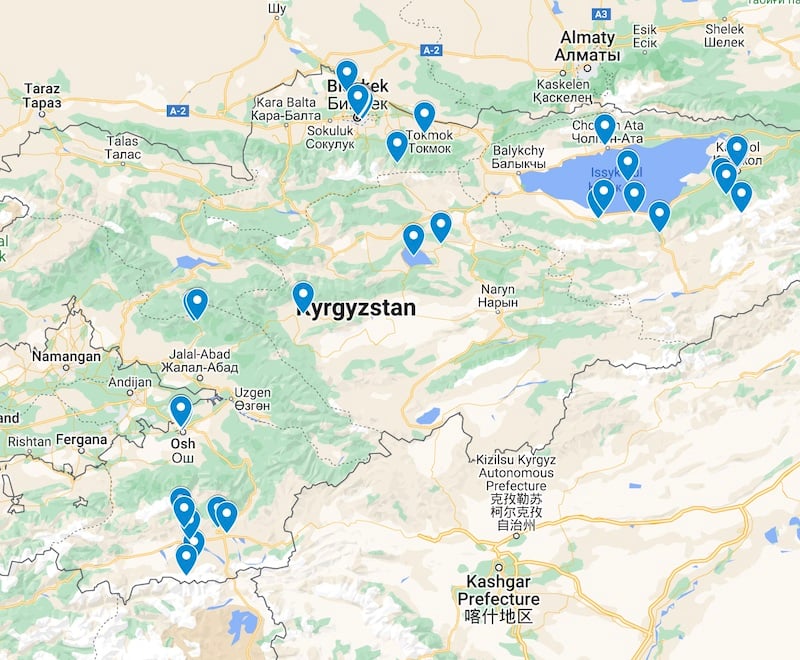Need help planning an unforgettable Kyrgyzstan itinerary?
Then you’re in the right place!
Known as the “Alps of Central Asia,” Kyrgyzstan is renowned for its stunning natural beauty and adventure activities like hiking, horseback riding, biking, and climbing.
Additionally, because it hasn’t (yet) been overtaken by mass tourism, it’s also possible to immerse yourself in local culture in an authentic way.
But, what are the best places to visit with 2 weeks in Kyrgyzstan?
The below itinerary shares exactly where to go and what to do—with essential tips for staying safe and preparing for your trip.
Note: This Kyrgyzstan travel itinerary is based on my experience traveling with Visit Alay, a local tour operator passionate about responsible tourism and supporting the local community. Along with selling pre-packed tours, they can also put together something custom based on your interests (which is what they did for me!).
 My top Kyrgyzstan travel recommendations include:
My top Kyrgyzstan travel recommendations include:
 Hotel: Sheraton Bishkek
Hotel: Sheraton Bishkek
 Tours: Viator
Tours: Viator
 Multi-Day Tour Operator: Visit Alay
Multi-Day Tour Operator: Visit Alay
 Recommended Excursions from Bishkek:
Recommended Excursions from Bishkek: 3-Day Horseback Riding Trip to Song-Kul Lake
3-Day Horseback Riding Trip to Song-Kul Lake Bishkek City Tour & Ala-Archa National Park
Bishkek City Tour & Ala-Archa National Park 3-Day Tour Around Issyk Kul Lake with Yurt Stay & Eagle Hunting Show
3-Day Tour Around Issyk Kul Lake with Yurt Stay & Eagle Hunting Show  Cuisine: Book a 4-Hour Private Bishkek Food Tour or a Pilaf Cooking Master Class
Cuisine: Book a 4-Hour Private Bishkek Food Tour or a Pilaf Cooking Master Class
 Travel Insurance: SafetyWing (budget-friendly) & World Nomads (robust); if you’re trekking, consider Global Rescue, which offers air evacuation services as well as a travel insurance add-on.
Travel Insurance: SafetyWing (budget-friendly) & World Nomads (robust); if you’re trekking, consider Global Rescue, which offers air evacuation services as well as a travel insurance add-on.
 Staying Connected: Saily eSIM (3GB was more than enough for 2 weeks in Kyrgyzstan)
Staying Connected: Saily eSIM (3GB was more than enough for 2 weeks in Kyrgyzstan)
Free Kyrgyzstan Itinerary Planning Resources
But first, before we go over tips for planning a trip to Kyrgyzstan, I invite you to grab my free Ultimate Travel Planning Kit — which includes 40+ travel resources — from printables to quizzes to itineraries — all meant to help you explore the world beyond the guidebook!
Some highlights of the kit include:
- Free “Where Should You Travel Next?” personality quiz
- Travel budget calculators to help you save money
- Pre-plotted Google Maps for 50+ destinations (including Kyrgyzstan)
- Printable travel journal with writing prompts
- Packing lists for different types of trips
- And more!
Once you’ve grabbed your copy, keep reading for tips for traveling to Kyrgyzstan in Asia.
Is Kyrgyzstan Worth Visiting?
If you’re an adventurous traveler or someone who loves immersing themselves in authentic local culture, spending 2 weeks in Kyrgyzstan is absolutely worth it.
Keep in mind, if you plan to travel beyond the big cities—which you should—you’ll need to be willing to say goodbye to some of your modern comforts like air-conditioned hotel rooms, ensuite bathrooms, and sometimes even beds depending on where you go.
Additionally, while yurt and guesthouse bathrooms are typically clean, public bathrooms are often outdoor pits with flies buzzing about. I highly recommend carrying a face mask for the latter!
In short, if you’re okay with swapping luxury for an incredible experience, you’ll have an amazing time.

Is Kyrgyzstan Safe?
According to the US Department of State, travelers should exercise normal precautions when visiting Kyrgyzstan, though you should reconsider travel near the border with Tajikistan due to the increased risk of violent border clashes.
Additionally, it’s ranked #77 on the Global Peace Index, indicating it has a medium level of peace.
Personally, I felt completely safe exploring Kyrgyzstan as a woman. In fact, there wasn’t a single time that I felt unsafe, both while exploring cities like Bishkek and Osh as well as more rural areas like Song Kol Lake and the Alay Mountains.
Best Time To Visit Kyrgyzstan
The best time to go depends on what you plan to do. That being said, in general, the summer months between late June and early September are typically the best time to travel in Kyrgyzstan—especially if you’ll be trekking or horseback riding.
Personally, I’d suggest doing your 2 week Kyrgyzstan itinerary closer to July or August, or even early fall, as I visited in late June and some of the mountain passes were still covered in snow.
Here is a photo of my group trekking down from Sary Mogul Pass in a total whiteout. And this was on June 24th!
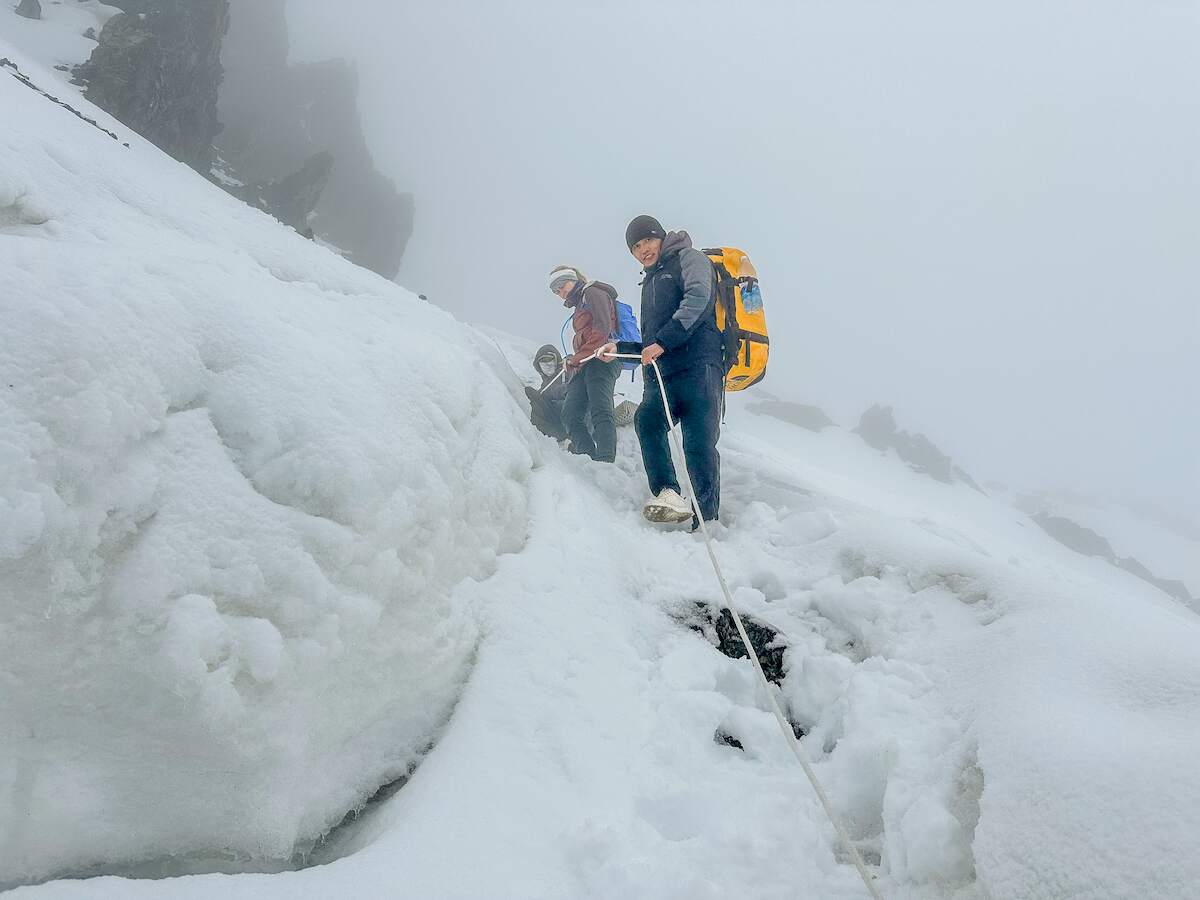
If you’re not trekking, you might consider visiting during the shoulder seasons of spring or fall when you can score better deals while avoiding hotter temperatures.
How To Get To Kyrgyzstan
International travelers will fly into Manas International Airport (FRU) in Bishkek. During my trip to Bishkek, I found the immigration and airport security to be quick and easy.
There are also loads of people offering taxi rides in the arrivals hall, though I booked my airport transfers through Visit Alay.
How To Get Around Kyrgyzstan
Personally, I hired a driver through Visit Alay, though we also met numerous travelers getting around with their own vehicles.
Having a driver was budget-friendly and a nice way to be able to relax, hang out with a local, learn more about the country, and be taken to the best spots. As the drives between places tend to be long, it’s also a great opportunity to take a nap!
Finally, other more niche ways that people get around Kyrgyzstan include by bike, which will be incredibly hard on the hilly terrain and is only recommended if you’re a very avid biker, and by horse.
Kyrgyzstan Travel Map
To help give you a lay of the land, here is a map for visiting Kyrgyzstan. It includes most of the main points and activities mentioned in the below 2 week Kyrgyzstan itinerary pre-plotted:
Click here for an interactive version of the above Google map.
2 Week Kyrgyzstan Itinerary (Overview)
Here is a quick look at where to go in Kyrgyzstan during a 2-week itinerary:
- 2 nights in Bishkek
- 1 night in Karakol
- 1 night in Kok-Jaiyk Valley (near Karakol)
- 1 night in Bokonbaevo Village
- 1 night at Song Kol Lake
- 1 night in Kazarman Village
- 1 night in Arslanbob Village
- 1 night in Osh City (to get ready for the multi-day trek the following 4 days, which is a shortened version of the Heights of Alay hike)
- 1 night at Tulpar Kul Lake
- 1 night in Sary Mogul Village (sometimes spelled “Sary Mogol”)
- 1 night near Sary Mogul Pass (sometimes written as “Pereval Sary-Mogol” as “Pereval” means “Pass”)
- 1 night Kosh Moinok Valley (sometimes written as “Kök-Moynok”)
- 1 night Osh City
I realize this Kyrgyzstan itinerary might feel fast-paced, but keep in mind that everything is pretty spread out, so it helps break up the drive.
For instance, if I were to cut any of the above, it would be Kazarman Village and Arslanbob Village; however, that would make the drive from Song Kol Lake to Osh City about 14 hours, so you really need to keep those stops. Plus, the drives between each spot are incredibly scenic.
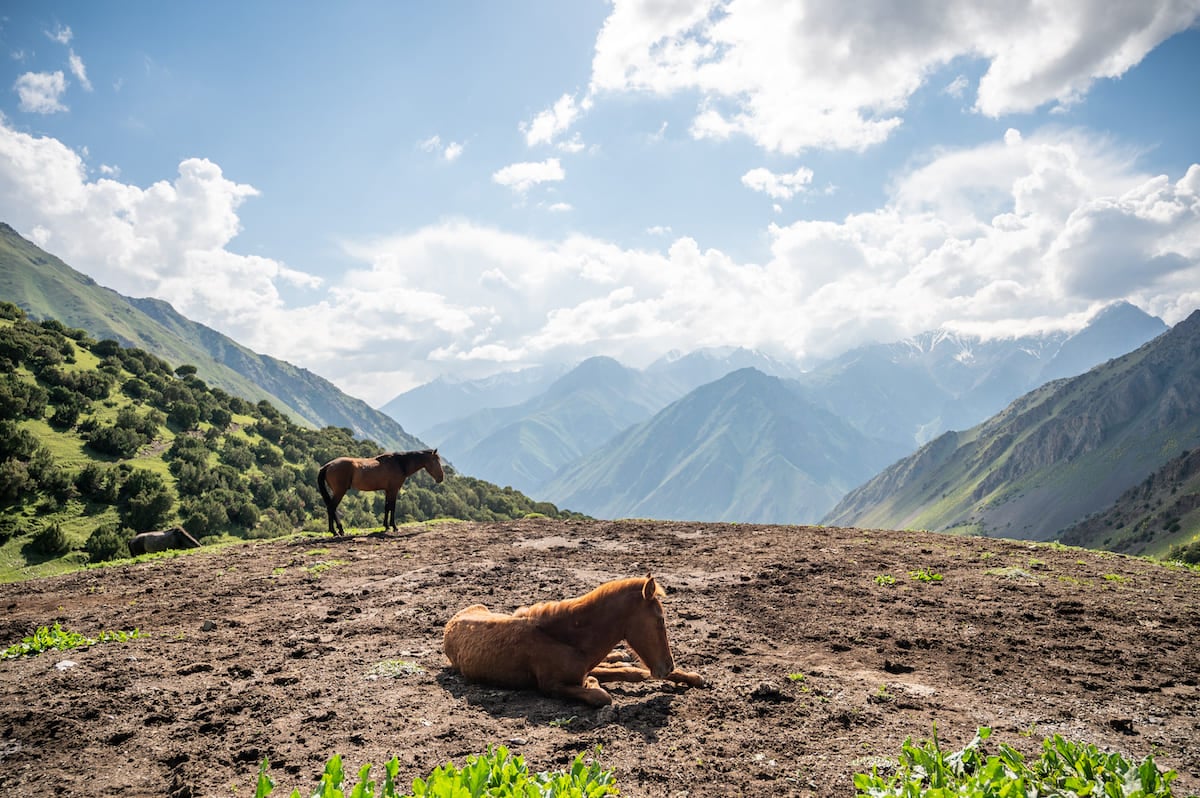
2 Week Kyrgyzstan Itinerary (Full Breakdown)
Now that we’ve quickly gone over where you should go for your Kyrgyzstan 2 week itinerary, let’s break down exactly what you should do and what the experience is like.
Again, this Kyrgyzstan itinerary is based on a trip I did through Visit Alay with my good friend and fellow travel blogger, Alex of Alex on the Map. My driver for the first half of the trip was Nurally and my guide for the trekking portion was Almaz.
Bishkek (Chuy Region)
Length: 2 nights
Tours: Click here for a list of top-rated Bishkek tours
Hotels: While I loved my stay at the clean and comfortable Garden Hotel & Spa, it was a bit removed from the main tourist attractions. To be more centrally located, consider booking a hotel near Ala-Too Square—like the Ramada by Wyndham Bishkek Centre or the Sheraton Bishkek.
Bishkek is the capital and largest city in Kyrgyzstan and is where international travelers arriving by air will start their trip.
With the stunning Tien Shan Mountains in the distance, it’s known for its wide boulevards, Soviet-era architecture, and cultural scene, with plenty to do and see—though, admittedly, I used it mainly as a place to rest and get acclimated to my new timezone.
The Garden Hotel & Spa was the perfect place for this, as it was clean and cute with lots of trendy accents like plants and cool seating areas. Rooms have air conditioning, high-speed wifi, and rain showers, and the property also includes a buffet breakfast with lots of options.
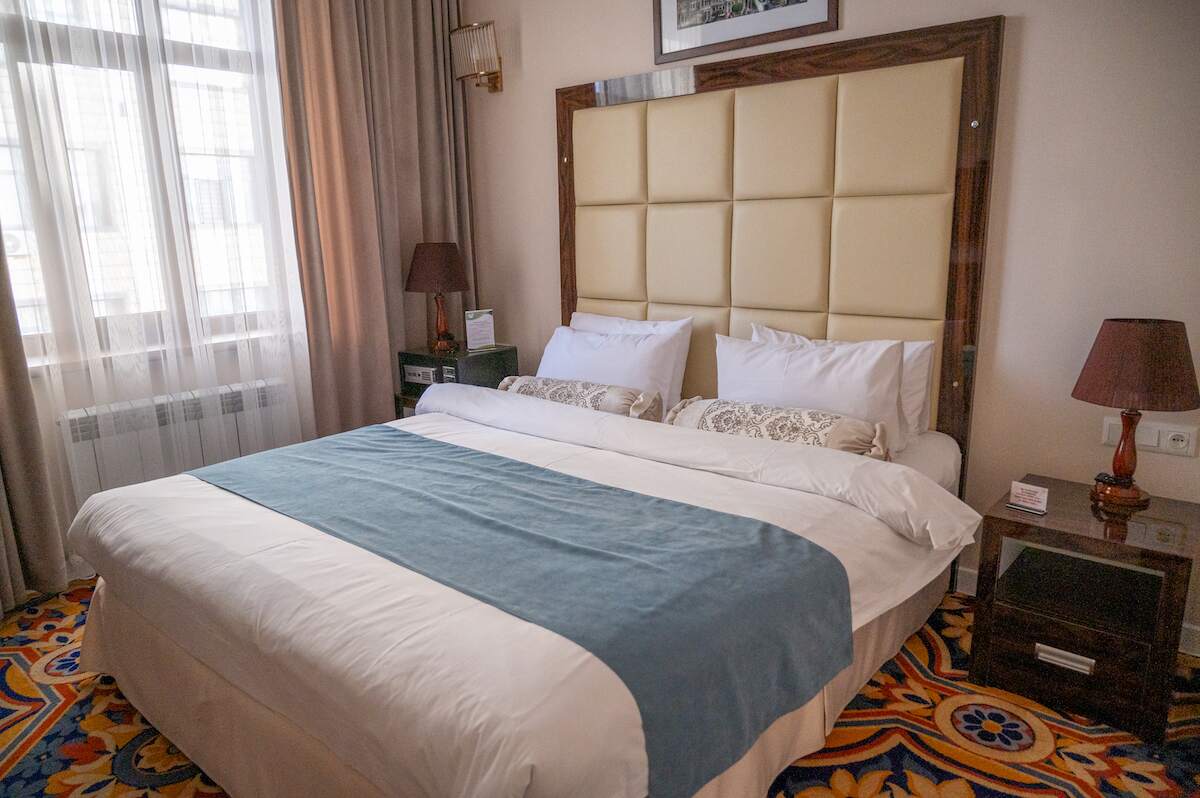
The only downside is you are about a 45-minute walk from many of the city’s main sites like the State History Museum, Panfilov Park, and Ala-Too Square.
Still, there is a convenient shopping arcade, money exchange, and supermarket across the street at Globus.
Additionally, there are some cute restaurants with outdoor seating nearby, including Baan Baan (Thai), Giraffe Coffee (cafe), and Adriano Restobar (European).
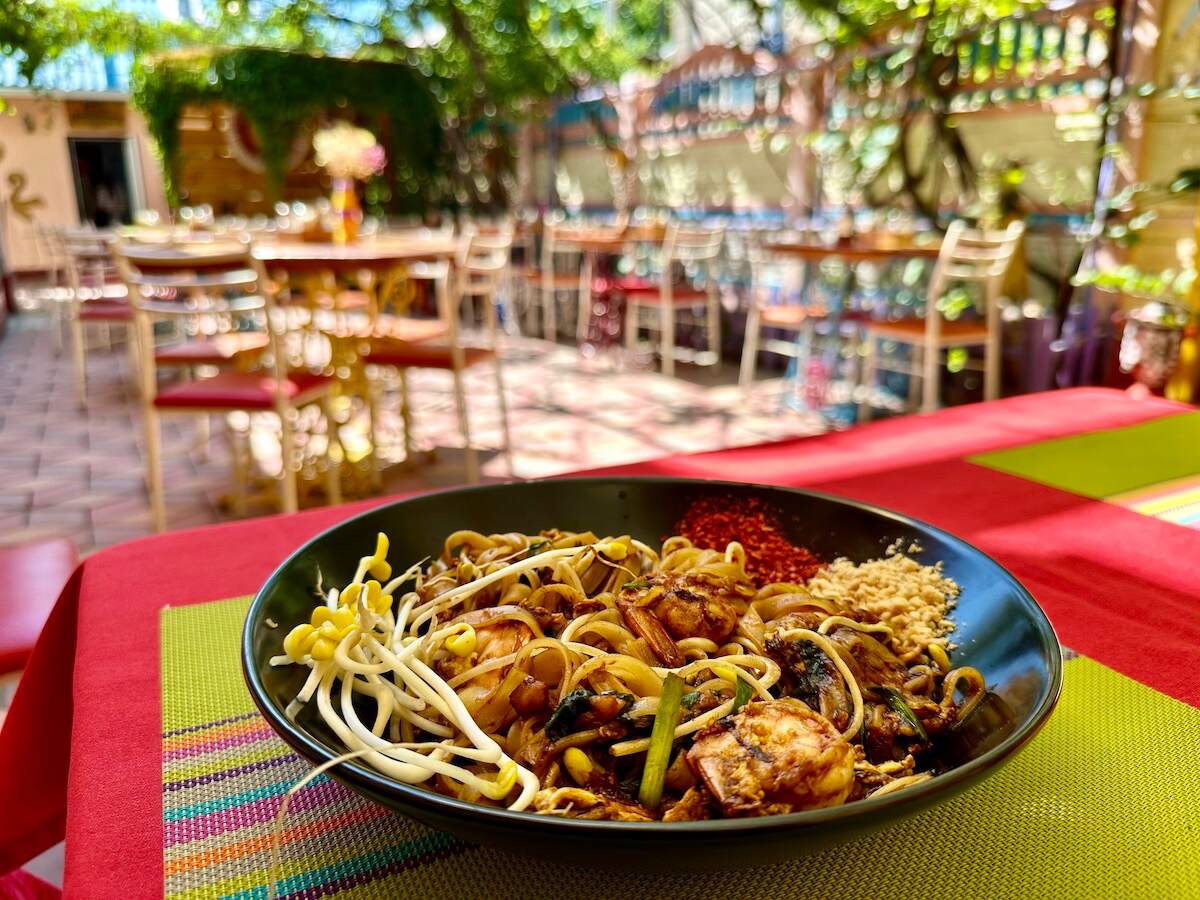
That being said, I’d only stay at the Garden Hotel if you’re looking to simply rest and save some money on your accommodation, as it’s cheaper than staying in the heart of the city.
Along with visiting the above-mentioned Bishkek attractions, consider shopping at the giant Osh Bazaar or booking a food tour or cooking class as well as a Bishkek city tour to gain a better understanding of the destination.
Karakol (Issyk-Kul Region)
Length: 1 night
Distance: 7 hours from Bishkek by car
Hotel: Hotel Mongu, a clean, modern, and sustainable hotel with a rooftop offering mountain views
The drive from Bishkek to Karakol, the fourth-largest city in Kyrgyzstan, offers mountain scenery and views of the countryside dotted with grazing cows.
Along the way, stop at Burana Tower (price: 140 som)—one of Central Asia’s oldest surviving minarets dating back to the 10th century when it was part of the medieval city of Balasagun, which was a key trade center on the Silk Road.
Visiting is one of the top things to do in Kyrgyzstan, especially since the attraction is designated a UNESCO World Heritage Site thanks to its cultural importance and the intricate history of Central Asian civilizations, offering insight into the architectural and societal developments of the region.
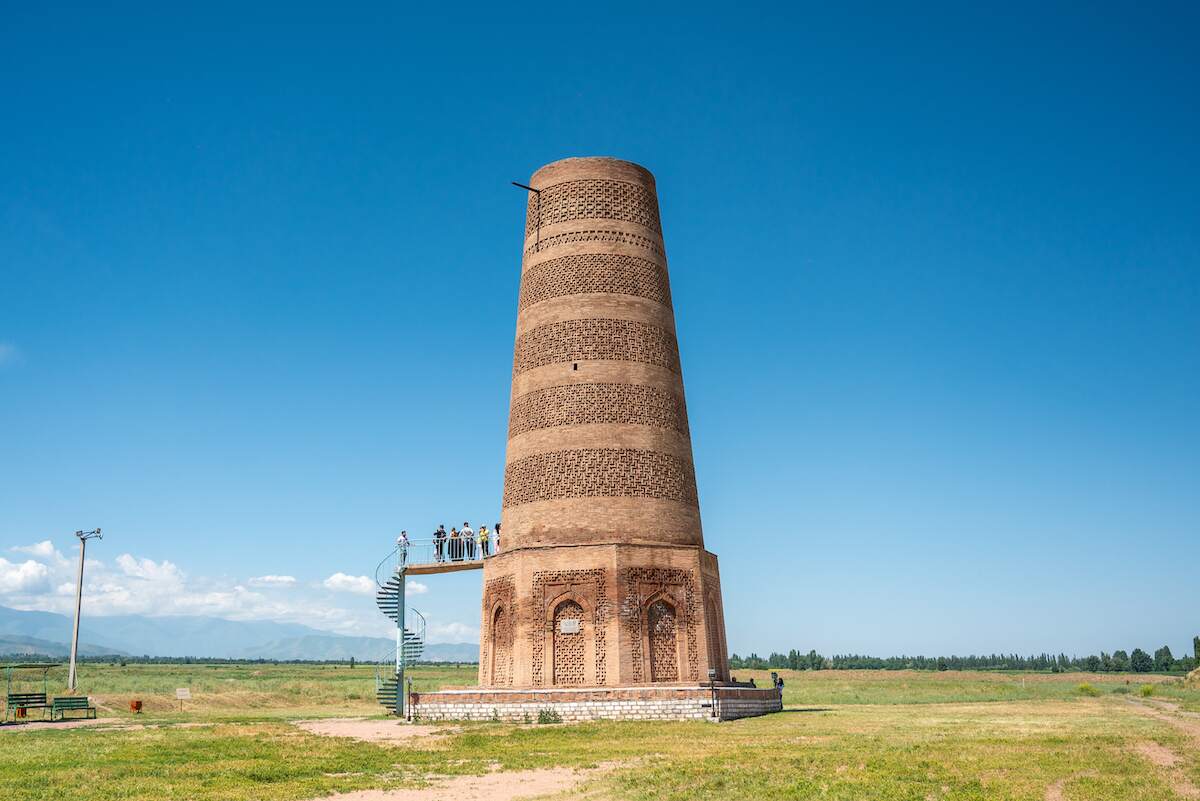
Onsite, you can walk a path that was once part of the Silk Road. There is also a small museum showcasing findings from the former archeological site like bowls, ceramics, pipes, jewelry, knives, mirrors, and even ancient eyebrow tweezers.
Another major highlight: climbing to the top of the 79-foot-tall tower for 360-degree views of the surrounding landscape—including the countryside backed by the stunning Ala-Too Mountains.
Another one of the Kyrgyzstan highlights we visit along the scenic drive to Karakol is the Open Air Petroglyph Museum in Cholpon Ada (price: 80 som)—a reserve with petroglyphs dating back to the 2nd millennium BCE to the 4th century AD.
As you walk the well-marked paths, there are scenes with goats and deer as well as many ancient Turkic stone sculptures. The majestic Ala-Too Mountains create the perfect backdrop.
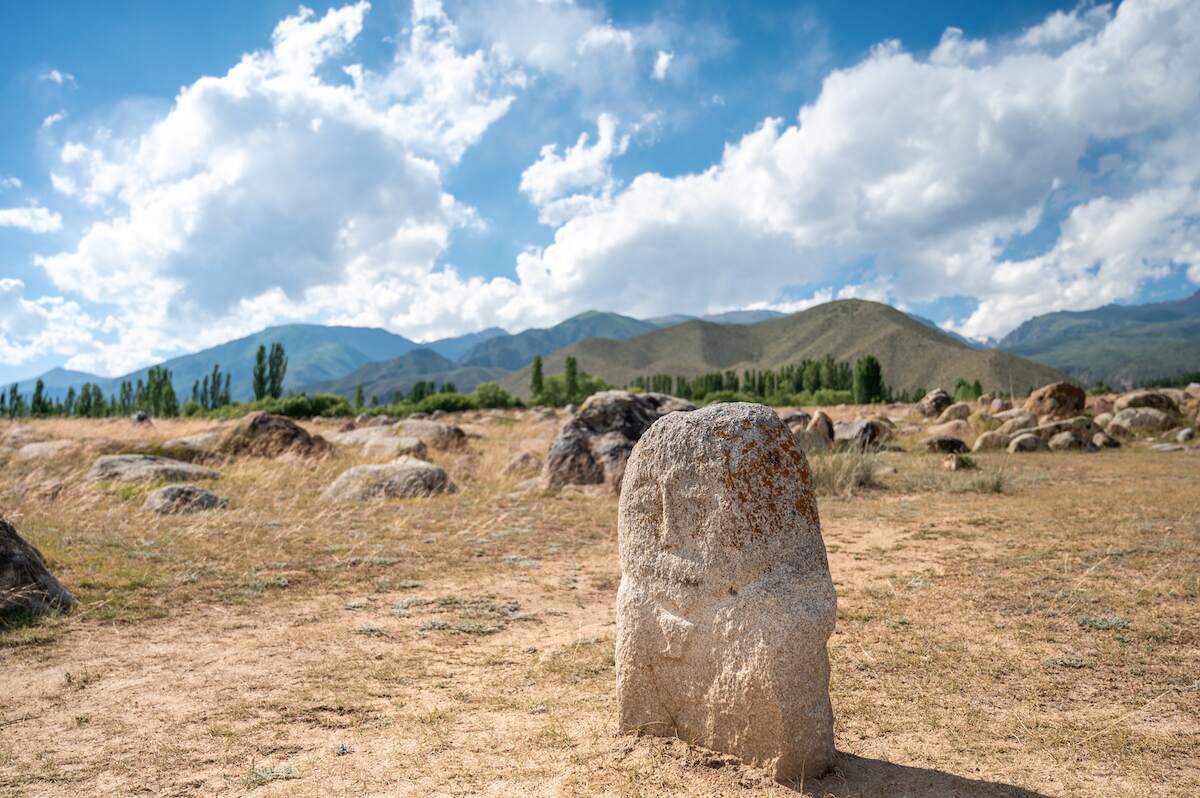
From here, it’s about 2.5 more hours of gorgeous mountain scenery, endless fields of lavender, and the country’s largest lake, Issyk Kul Lake, to get to Karakol.
This tourist-friendly city is a must-visit when you travel Kyrgyzstan as it’s filled with things to do—including dining at the famous Dastorkon Restaurant. While the focus is on Central Asian dishes made in the traditional method, they serve burgers and pizzas too.
We start with some borsook, which are small puffs of fried dough that you dip in cream. From there, I order the Uyghur Laghman featuring hand-pulled noodles, vegetables, and beef, which is one of the most popular foods in Kyrgyzstan.

(I’m actually a vegetarian as it didn’t mention beef and was in the vegetarian section on the menu, but I just picked out the meat and gave it to Nurally to add to his dish. If you’re veggie, double-check with the server. This goes for all over Kyrgyzstan, where eating vegetarian is a pretty foreign concept.)
Along with the food, a major highlight of the restaurant is the cultural performances. The two young women playing the komuz—a plucked string instrument that is the national instrument of Kyrgyzstan—were amazing!
Finally, we arrived at our destination for the night, Hotel Mongu, which offered comfortable and clean rooms, WiFi, air conditioning, and a filtered water jug to fill your water bottle.
That being said, the major highlight is a huge and delicious breakfast on the terrace with stunning views of the snow-capped Ala-Too Mountains.
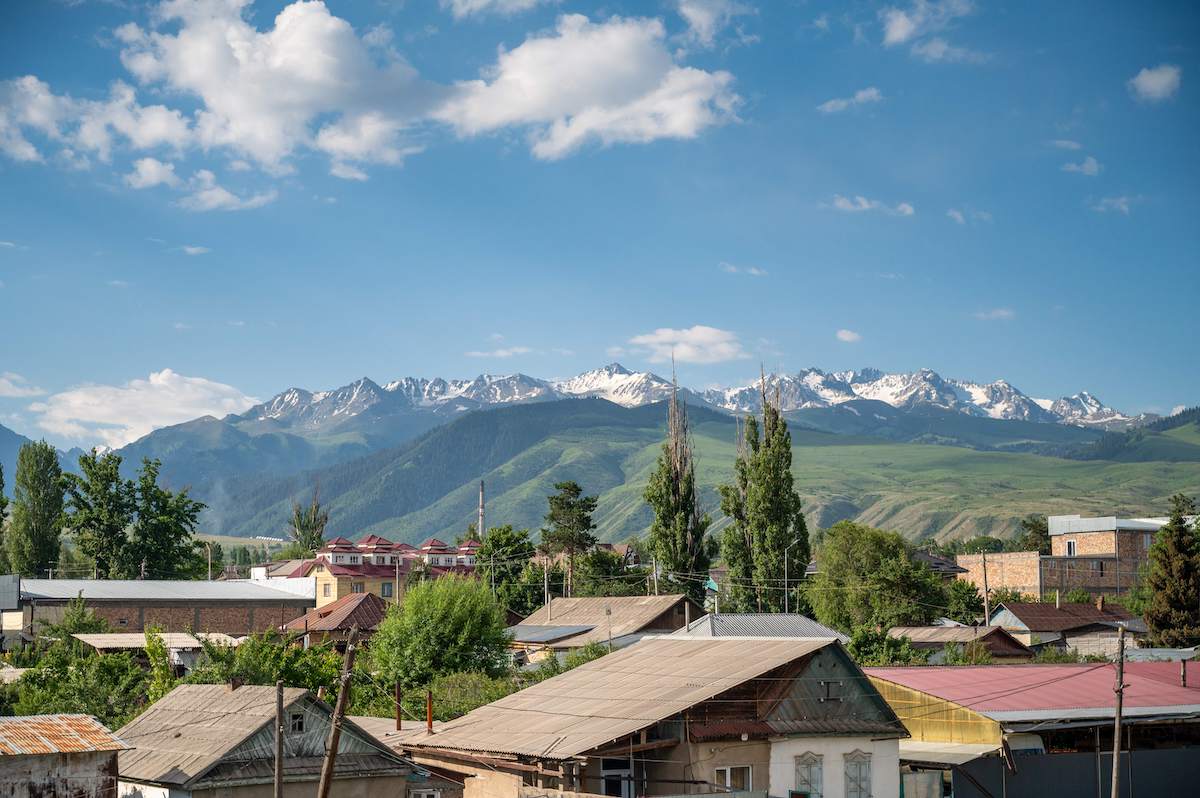
Kok-Jaiyk Valley (Issyk-Kul Region)
Length: 1 night
Distance: 1 hour from Karakol City by car
Accommodation Kok-Jaiyk Yurt Camp
The next stop on our Kyrgyzstan itinerary for 2 weeks was Kok-Jaiyk Valley, which would also be the starting point for our first hike of the trip.
Along the drive, there are numerous visual highlights, like Jeti-Oguz Canyon (7 Bulls Rock) named after the giant rock red outcroppings protruding from the hillside, and Broken Heart Rock, an enormous rock split in two.
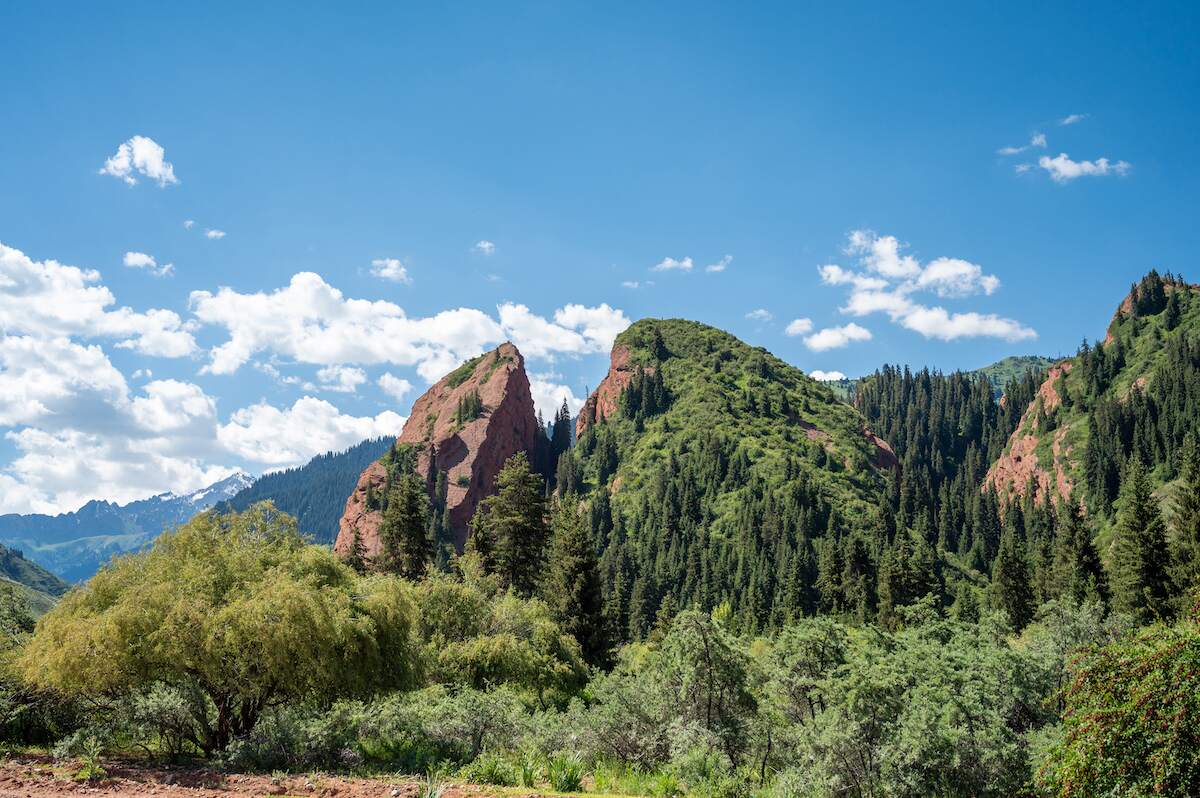
Further up, the gushing Jety-Oguz River flows fervently with yurts and horses in the foreground, some running freely and others being ridden by locals and tourists.
Horseback riding is one of the main attractions of the area, as is trekking—which we experience firsthand on a trek to see a panoramic view of Oguz-Bashi Peak (Yeltsin Peak) in the heart of Tian Shan Mountain Range.
This turned out to be quite an interesting adventure. The scenery along the way is absolutely stunning, with tall trees towering above the glistening river and cows grazing near yurts—plus the giant mountains looming in the distance.
Along the way, a local woman with two young children invited us into a small hut featuring a table adorned with tea, cookies, katama (onion-filled swirled flatbread), and bread rounds with jam and fresh cream.
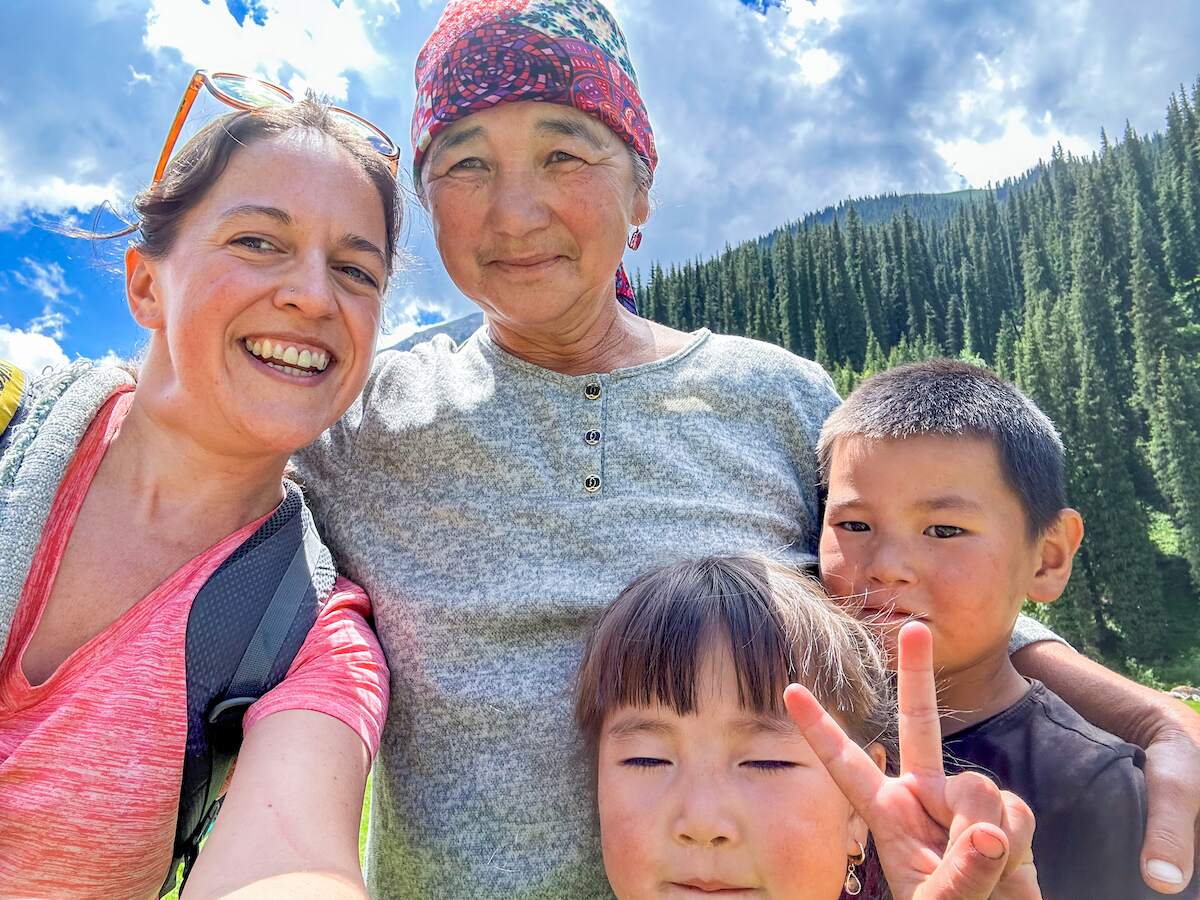
While we didn’t speak the same language, we did learn that she had 14 grandchildren and that the little boy and girl wrestling across the table were two of them. It was a fun little side trip on the hike.
Continuing on, we eventually missed the right turn we needed to take and hiked too far. When we came back, we made another wrong turn up a cow path.
Luckily, the third time was the charm and we eventually found the path. The key: you make a right at the wooden bridge and then go right again immediately, heading toward the river.
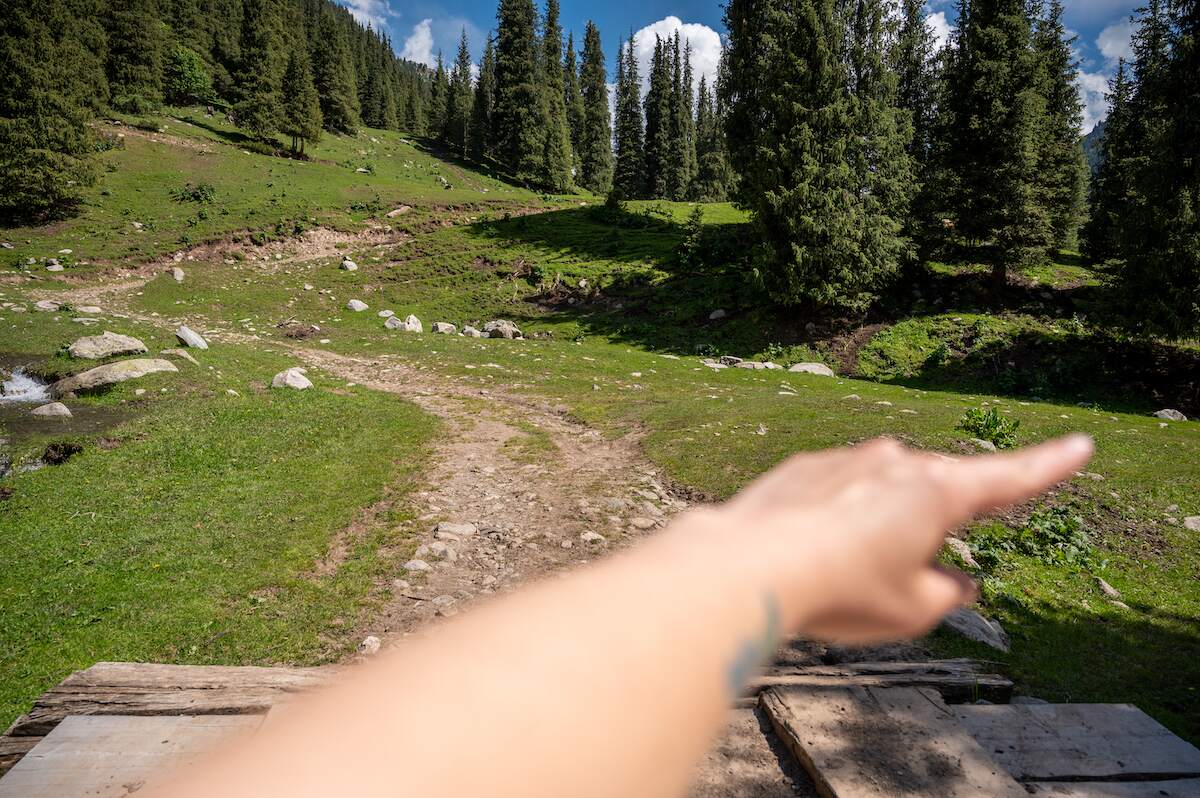
Unluckily, the mud situation was like quicksand, pulling us down into the earth. At one point, Alex got sucked so far down the mud came up to her knees, pushing her forward onto her hands.
“You’re getting a Kyrgyzstan baptism it appears!” said a tourist passing by on horseback.
I laughed, “It looks like riding a horse may have been the better way to do this.”
Luckily, after about 15 miles of muddy quicksand we finally reached solid ground—and the epic view!
Was it worth it? Here is a photo to help you decide for yourself. Spoiler: I think it was!
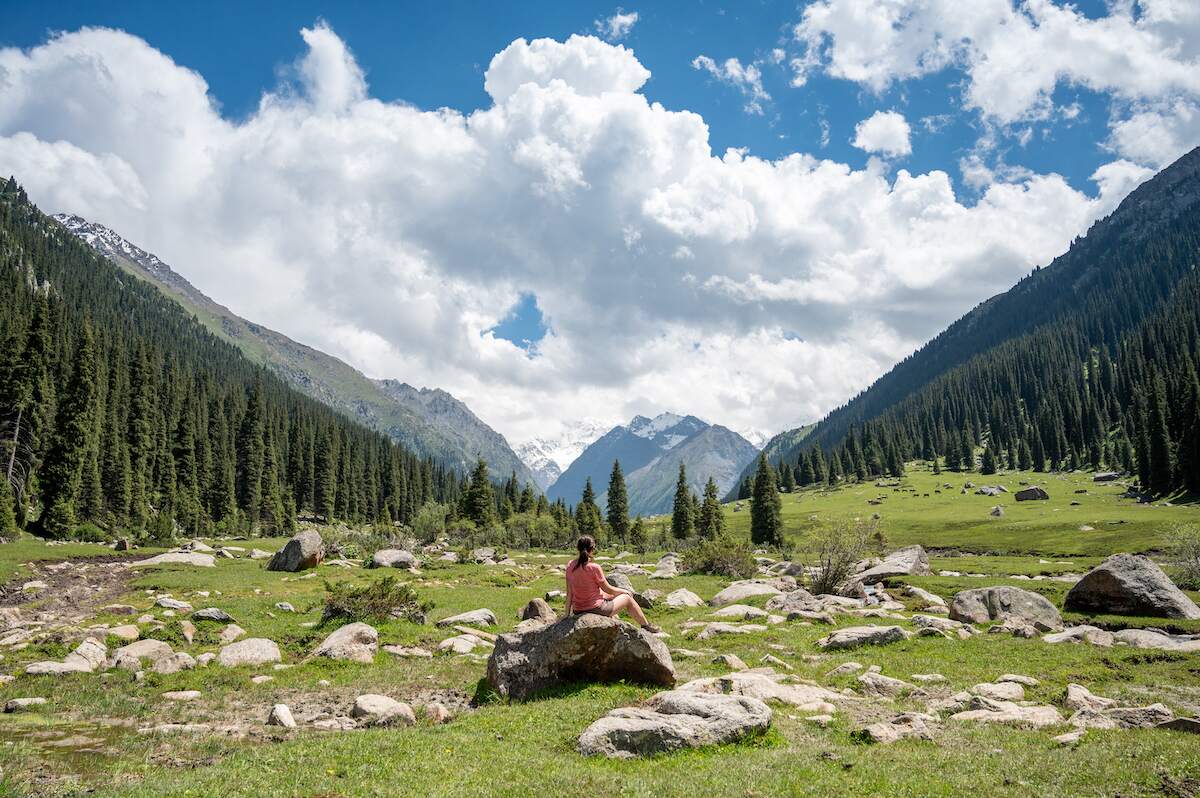
On the way back, we realized there is a path all of the way to the side that allows you to bypass the mud. Keep an eye out for this if you do this trail during your 2 weeks in Kyrgyzstan.
The walk back is just as beautiful, and we eventually get to our yurt accommodation, Kok-Jaiyk Yurt Camp for the night.
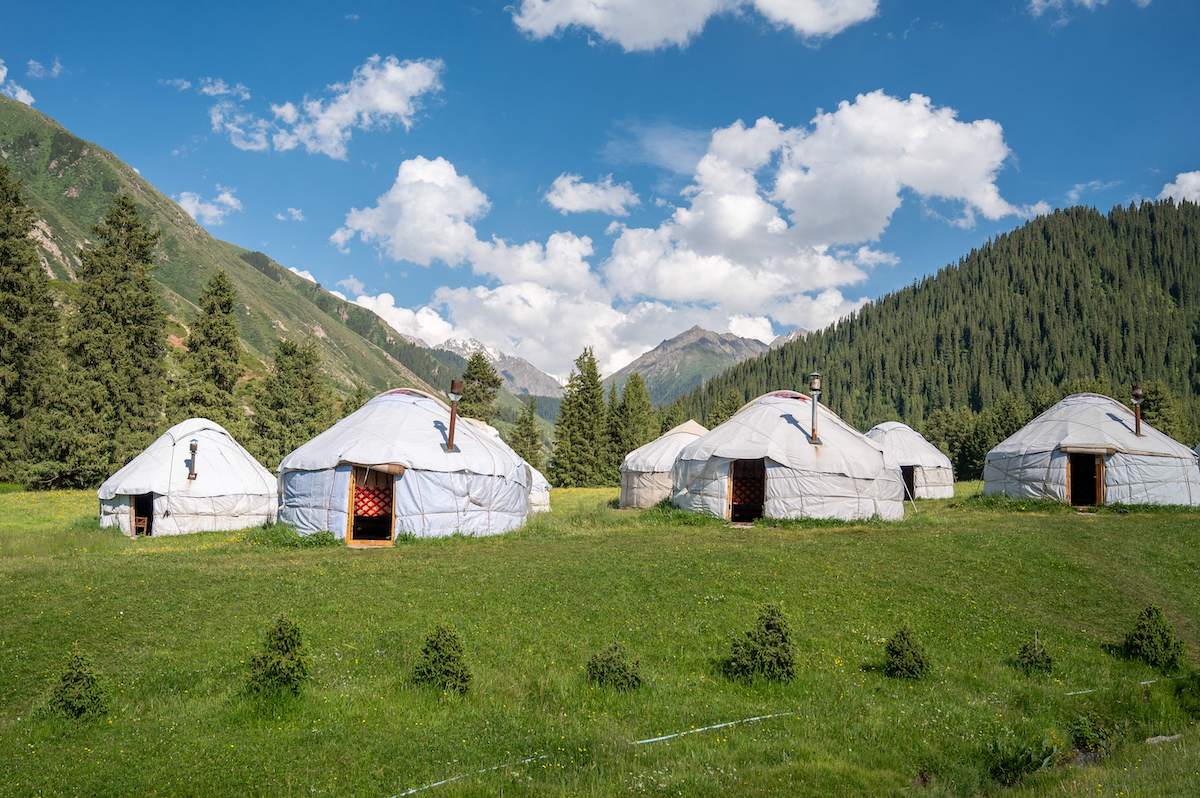
While traveling through Mongolia for 2 weeks last year, I stayed in quite a few yurts, and this one felt luxurious with comfortable beds and western toilets—not to mention a delicious family-style dinner of black tea, boorsok, bread, soup-style Laghman, boiled vegetables with beef, cookies, and candy.
It’s the perfect way to end the day. At night, tucked into our cozy yurt beds, we listen to the flowing river as it lulled us to sleep.
Bokonbaevo Village (Issyk-Kul Region)
Length: 1 night
Distance: 4 hours from Kok-Jaiyk Valley by car
Accommodation Bell Tam Seaside Yurt Camp, a trendy yurt camp on the water designed to look like an old pioneer town
Next up on the Kyrgyzstan 2 weeks itinerary is Bokonbaevo Village, with the first stop along the drive being a lookout over Jeti-Oguz (7 Bulls Rock). The viewpoint also offers 360-degree views of the valley out toward Oguz-Bashi Peak.

The drive itself is breathtaking, with opportunities to photograph the endless rows of purple and yellow flowers backed by high peaks.
We pass rows of apricot trees, lovely little beaches along the enormous Issyk Kul Lake, and giant slopes rising from the ground with clouds billowing around the peaks until we come to the 24-meter (79-foot) Barskoon Waterfall.
Along with yurt camping and a restaurant at the base, there is a 1.8-mile hike to the top with an almost 13,000-foot elevation gain.

After doing it myself, I can say it is very strenuous but also very beautiful, with a variety of stunning lookout points showcasing the falls tumbling down from the mountains.
Another not-to-miss nearby Kyrgyzstan attraction is Fairytale Canyon or Skazka Canyon (price: 50 som)—which feels like a completely different world with desert-like terrain and colorful slopes and hoodoos that form fairytale creatures (hence the name).
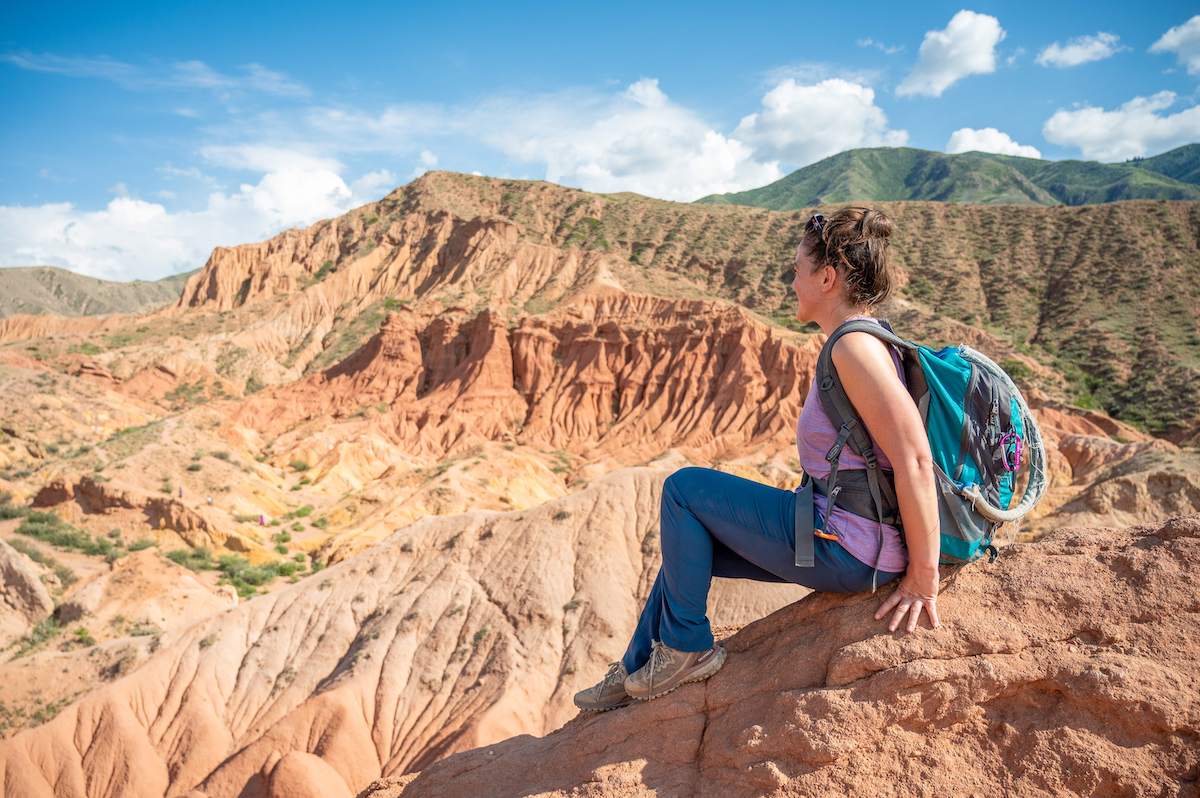
Archeological evidence suggests that the Issyk Kul basin was once home to a few powerful cities.
According to legend, in one of these cities lived a beautiful young woman who captured the heart of a massive red dragon. Despite his love for her, she did not return his affections, leading the dragon to vow to drown the cities in the valley.
Each night, he used his magic to draw water from the wells, but the resourceful locals thwarted him by covering the wells with golden lids. One fateful night, the young woman forgot to cover her well, allowing the dragon to unleash a flood that filled the valley and formed the lake.
Mesmerized by the lake’s beauty, the dragon lay down on the southern shore and turned into stone. This transformation, as the legend goes, is how Fairytale Canyon came into being. Of course, in reality, we have Mother Nature to thank for the epic scenery.
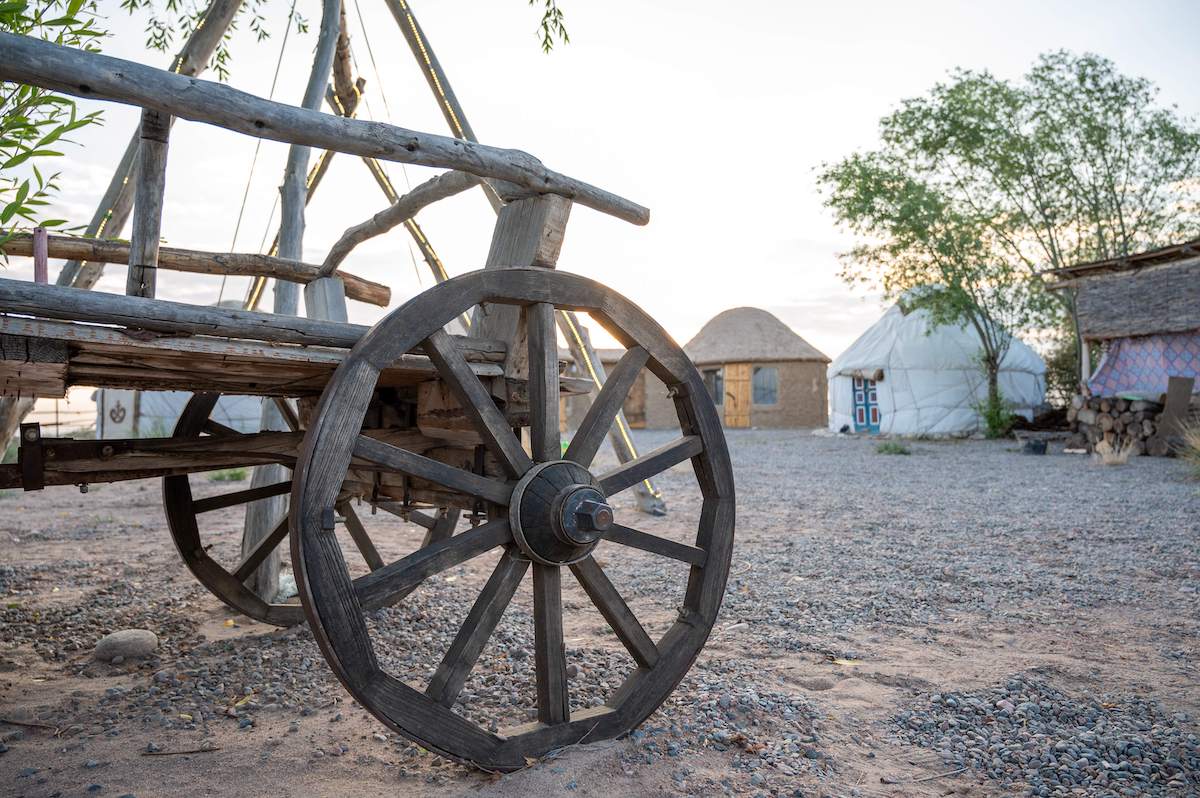
Our accommodation for the night is Bell Tam Yurt Camp. Sitting on the shore of Issyk Kul Lake, it reminds me of the Kyrgyzstan version of a pioneer town with wheelbarrows, a hay-topped wooden pavilion, and an old wooden “bar” sign.
It has luxury amenities like western toilets, hot showers (with rain shower heads and stone floors), and even massages for 15 Euros!
Song-Kul Lake (Naryn Region)
Length: 1 night
Distance: 5 hours from Bokonbaevo Village by car
Accommodation CBT Kochkor 7 (CBT stands for Community-Based Tourism)
While traveling in Kyrgyzstan, one cultural experience that should definitely be on your itinerary is an eagle hunting masterclass.
After a buffet breakfast at the yurt camp, we set off to meet Tailgate, whose family has been eagle hunting for generations.
We also meet his trusty golden eagle Aitunuk (meaning “crystal clean moon”), who he captured and raised since she was a baby. Female eagles are preferred for hunting due to their larger size, and their 3-month training begins when they are around 2 months old.
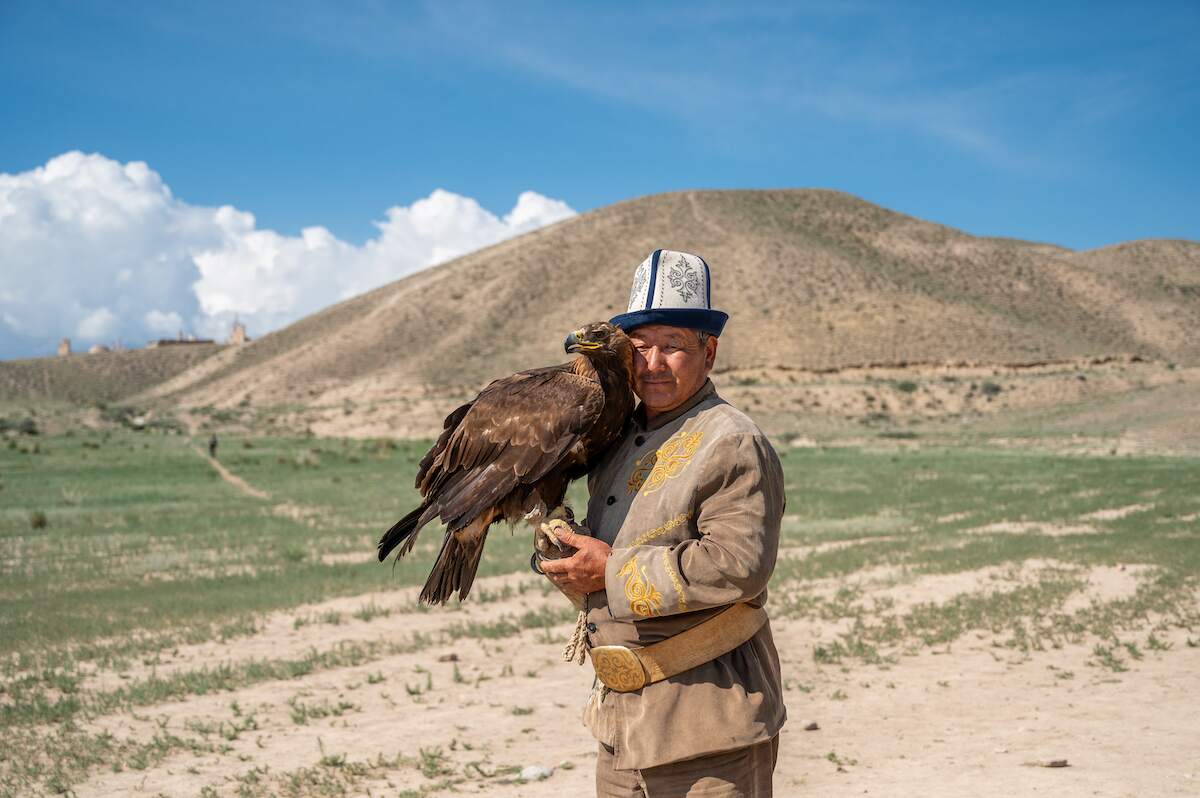
The eagles hunt foxes and jackals during winter, occasionally even taking on wolves—which is possible thanks to their incredibly strong vision and ability to exert powerful pressure to kill their prey.
To bring this to life, Tailgate puts on a demonstration that shows how he trains Aitunuk by running with a pelt that has meat on top of it, which Aitunuk flies at with great speed before lunging, chowing down ferociously before adorably cleaning her beak on a stone.
We also do an archery demonstration—which is another one of Kyrgyzstan’s national sports, particularly when people shoot arrows while on horseback.
Archery takes a lot of arm strength and with Tailgate’s guidance of keeping my left arm straight and pulling my right arm back and up, I’m able to hit the target.
 Pro tip: Want to do an eagle hunting masterclass, but aren’t doing this exact Kyrgyzstan itinerary? You can also book an experience from Bishkek, like a 3-Day Tour Around Issyk Kul Lake with Yurt Stay & Eagle Hunting Show.
Pro tip: Want to do an eagle hunting masterclass, but aren’t doing this exact Kyrgyzstan itinerary? You can also book an experience from Bishkek, like a 3-Day Tour Around Issyk Kul Lake with Yurt Stay & Eagle Hunting Show.
Back in the car, the stunning drive continues to Song-Kul Lake. A few visual highlights include the Kochkor Reservoir and its bright blue water backed by rocky red peaks.
There’s also the 3,447-meter (11,309-foot) Kalmak Ashuu Pass showcasing expansive green hills and valleys leading to snow-capped mountains under a cloudy sky.

This beauty only continues as we arrive at CBT Kochkor 7, one of the many yurt camps set up along the shores of Song Kul Lake.
With a glistening lake on one side and majestic mountains on the other, not to mention horses grazing and galloping everywhere you turn, it’s quite a scene—especially at sunset.
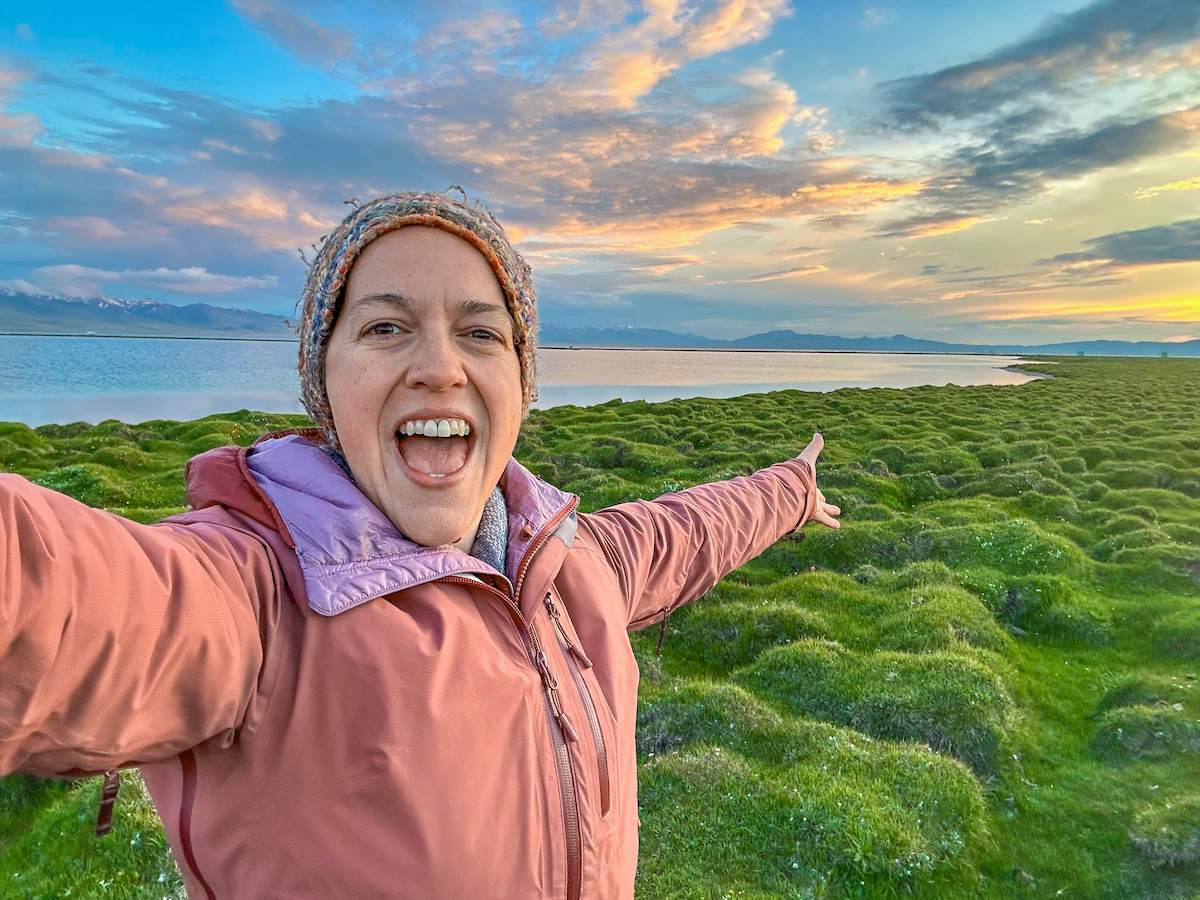
While shooting, I meet another American who asks with wide eyes, “How did you even find this place?!”
After driving for hours on bumpy dirt roads and passing nothing but rolling hills, mountain peaks, and sheep, it’s a place that truly feels like the end of the earth.
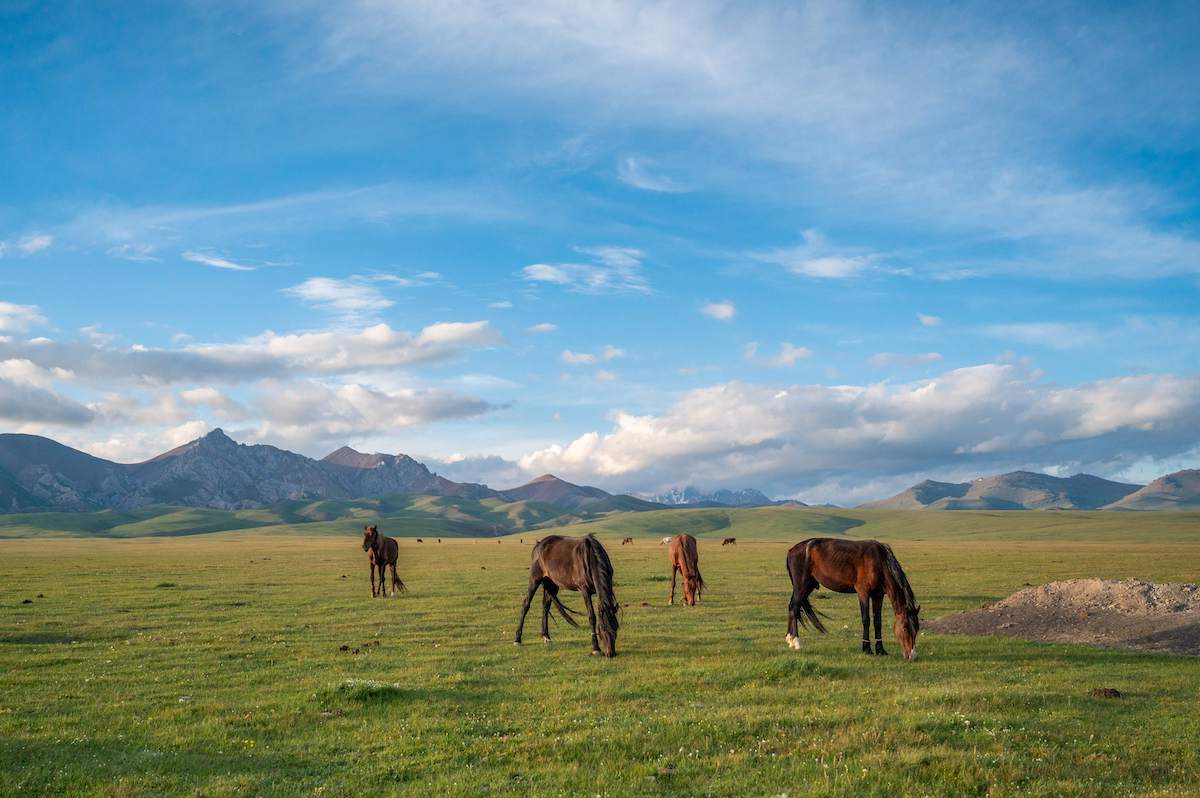
Following a horseback ride along the lake, we settle into a cozy kitchen housed in a shipping container. Dinner is prepared by the legendary Rahima, who warms up our shivering bodies with warm beef and vegetable soup followed by dumplings.
The table also features a lavish spread of breads, jams, butters, fruits, nuts, and more.
After dark, a young woman comes to light a fire to help warm our yurt, and we fall asleep snuggly while listening to silence punctuated by the occasional dog bark or horse nay. Seriously, no Kyrgyzstan guide would be complete without mentioning this incredible place!
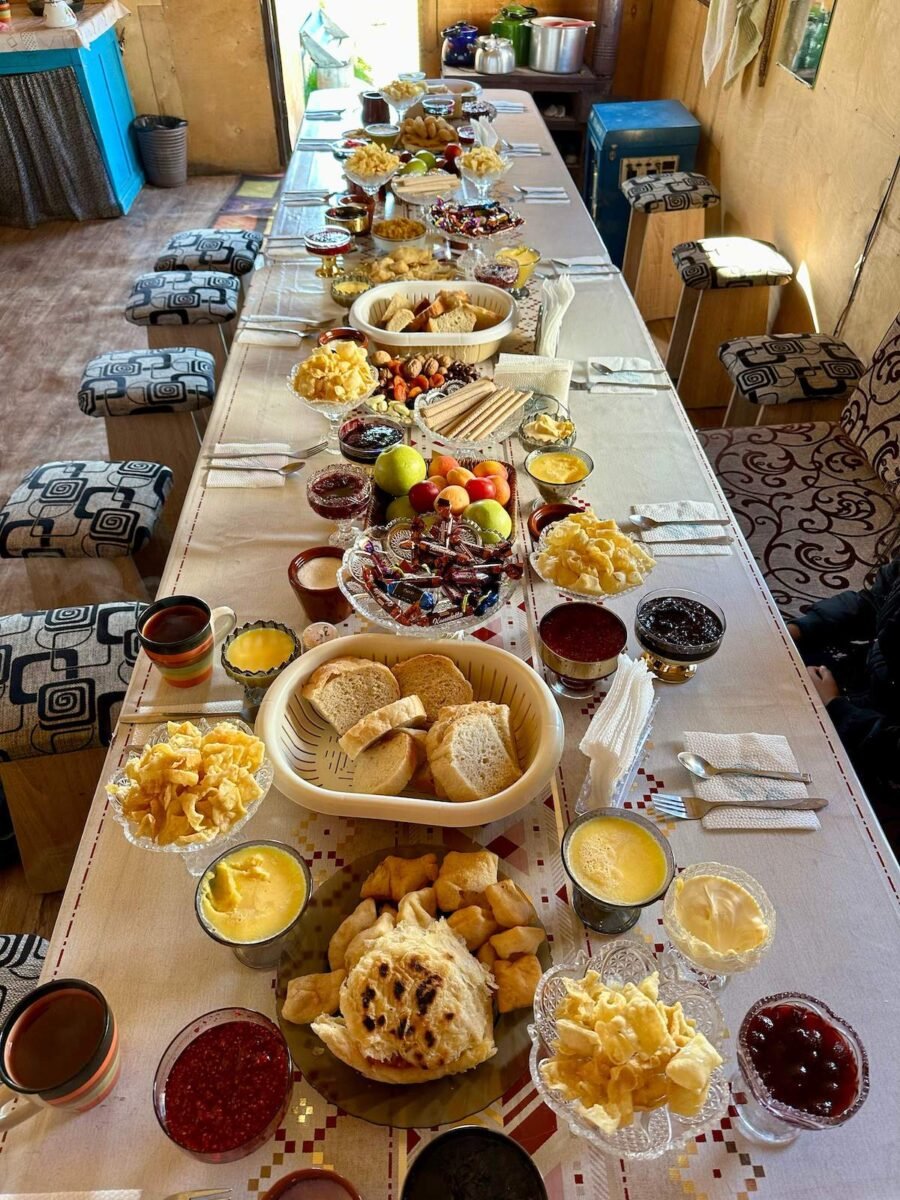
Kazarman Village (Jalal-Abad Region)
Length: 1 night
Distance: 7-8 hours from Song-Kul Lake by car
Accommodation: CBT Kazarman (35 Kadyrkulova Street), a clean and comfortable guesthouse with delicious and filling meals and hot showers
While today’s long journey to Kazarman Village includes a lot of driving, it’s one of the more scenic days of our Kyrgyzstan 2 week itinerary.
We ask Nurally to pull over 20+ times to take photos of the yellow-dotted meadows with grazing cows, the trotting horses and their flowing manes, and the colorful Ala-Too Mountains and their color-swirled peaks.
The view from Asylbek Tologonov Tuz Ashuu Pass is particularly stunning:
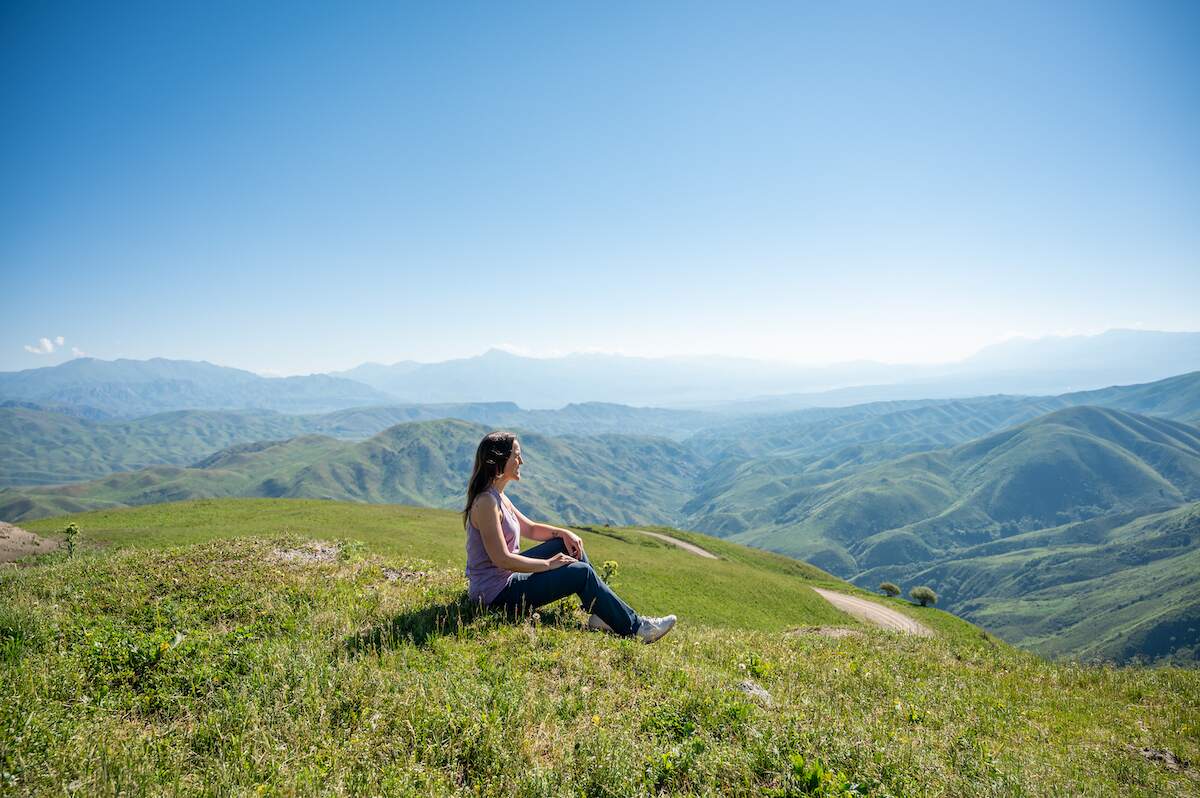
While there isn’t a ton to do in Kazarman Village itself, it is a popular stopping point as travelers make their way between Song-Kul Lake and Osh City.
Our guest house in Kazarman is CBT Kazarman—which offers a simple and clean room and an amazing menu of foods made with local ingredients.
For instance, dinner features beshbarmak (long flat noodle, potato, carrots, beef); fresh tomatoes, cucumbers, and peppers in soy sauce; and a sort of chef salad—all homemade with local ingredients.
Of course, there is also a pot of tea, fruits, and a bowl of candy and cookies on the table, as is customary in Kyrgyzstan. You certainly won’t go hungry at this homestay!
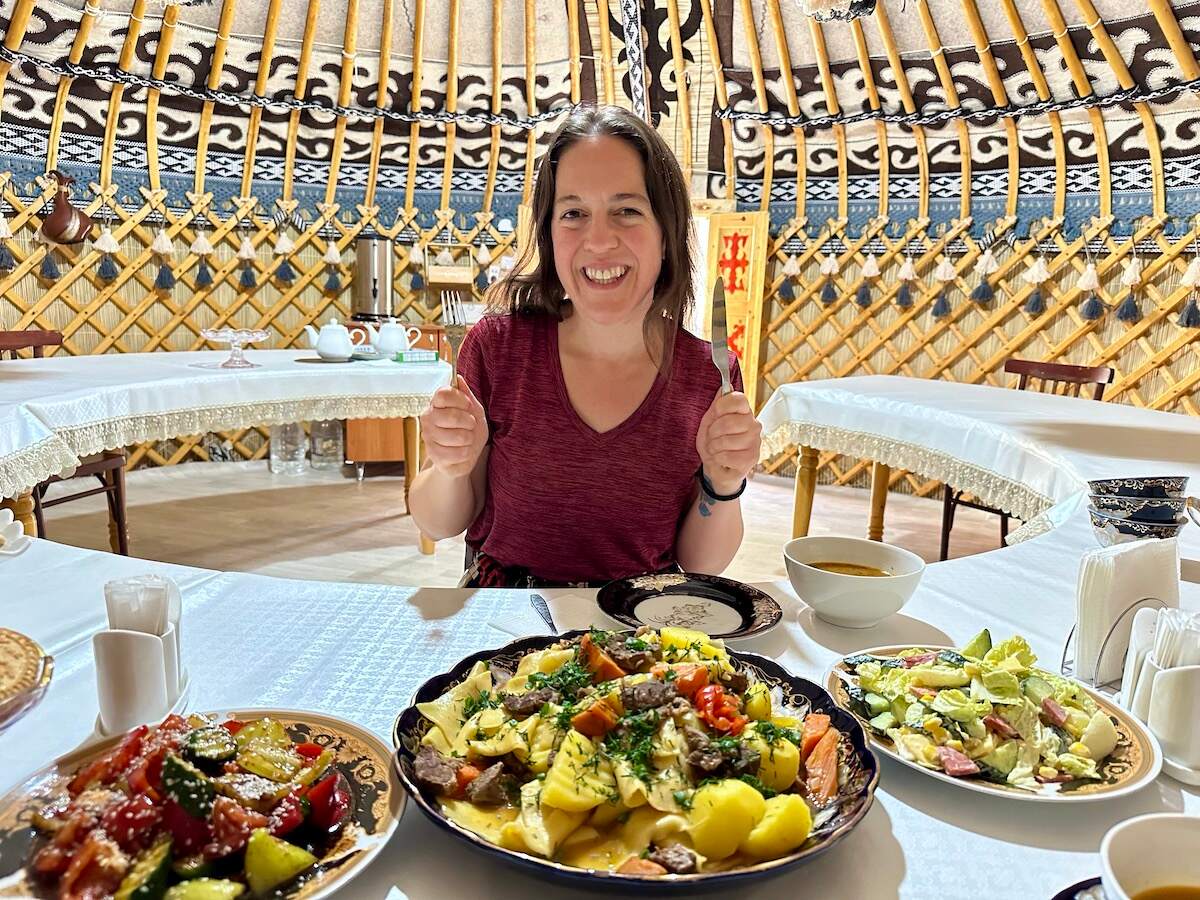
Arslanbob Village (Jalal-Abad Region)
Length: 1 night
Distance: 6 hours from Kazarman Village by car
Accommodation: Arslanbob Homestay
On the road again, we make the long, windy, and bumpy drive toward Arslanbob Village, stopping at Kaldama Pass for breathtaking panoramic views of Kyrgyzstan’s peaks from over 8,000 feet (2,438 meters).
While driving in Kyrgyzstan, you should prepare for lots of unpaved roads. Luckily, after a few hours, we’re off the mountain and on flat ground again, my head no longer bouncing against the headrest.
It doesn’t last long though. Once in Arslanbob—a village famed for having the world’s largest walnut forest at 11,000 hectares (27,000 acres)—we switch vehicles and hop in a 2005 Russian Lada Niva for an off-roading adventure to the 30-meter (98-foot) Small Arslanbob Waterfall (price: 20 som).

An uphill walk from the parking lot offers a carnival atmosphere, with locals selling plastic toys, cheese balls, and candy. There are carnival games, music, ziplining, and, the highlight, the chance to take a dip in the waterfall.
Afterward, we head to a famous Panoramic Viewpoint with paintball, giant swings, ziplining, and the chance to take in a view from above the city.
We end the tour with another side trip to the larger Big Arslanbob Waterfall, which involves a short hike through a ravine to get to the base of the 80-meter (263-foot) cascade.
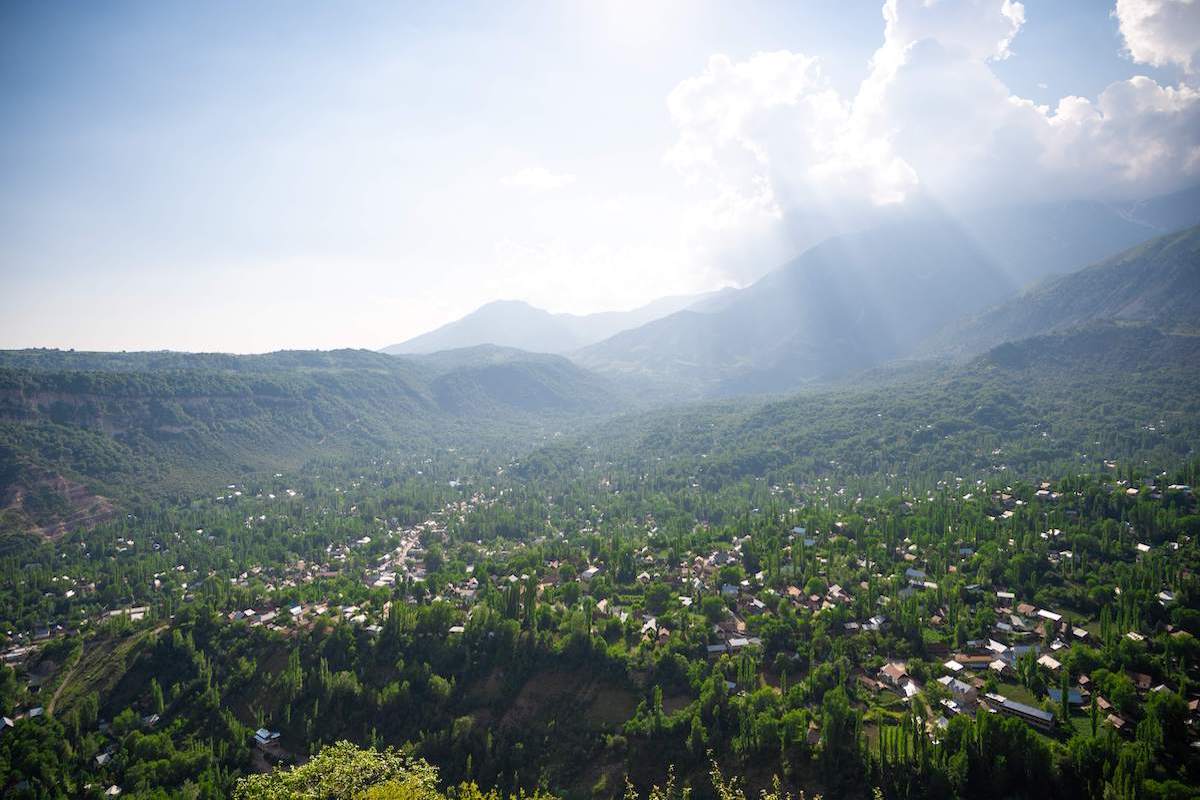

Dinner that night is at our guesthouse, Arslanbob Homestay, where we eat in a little pagoda with comfortable cushions on benches.
Along with a bowl of Arslanbob’s famous walnuts, we enjoy bread with honey, salad, and heaping plates of plov. It was one of the best meals I had in Kyrgyzstan!
Osh City (Osh Region)
Length: 1 night
Distance: 7 hours from Arslanbob Village
Accommodation: Osh Grand Hotel Chavo, a comfortable and clean hotel with a restaurant and air-conditioned rooms
Today is spent journeying to Osh—the second-largest city in Kyrgyzstan after Bishkek—to rest and prepare for the upcoming 4-day trek from Tulpar Kul Lake to Kojokelen Village.
We’ll be doing a shortened version of the Heights of Alay hike—though if you have extra time in your Kyrgyzstan itinerary it’s recommended to do the full trek.
While I mainly just rested, a few attractions to check out when visiting Osh include:
- Sulaiman-Too Sacred Mountain, a popular spot for hiking, seeing petroglyphs, and worship (since it’s a holy site). While there, you can also visit the National Historical and Archaeological Museum Complex Sulayman.
- Central Asia’s tallest Vladimir Lenin Statue, which stands 25 meters (82 feet) high.
- Jayma Bazaar, a historic outdoor market dating back 2,000 years.
- Alisher Navoi Park, an amusement park area with restaurants, food stalls, rides, and more.
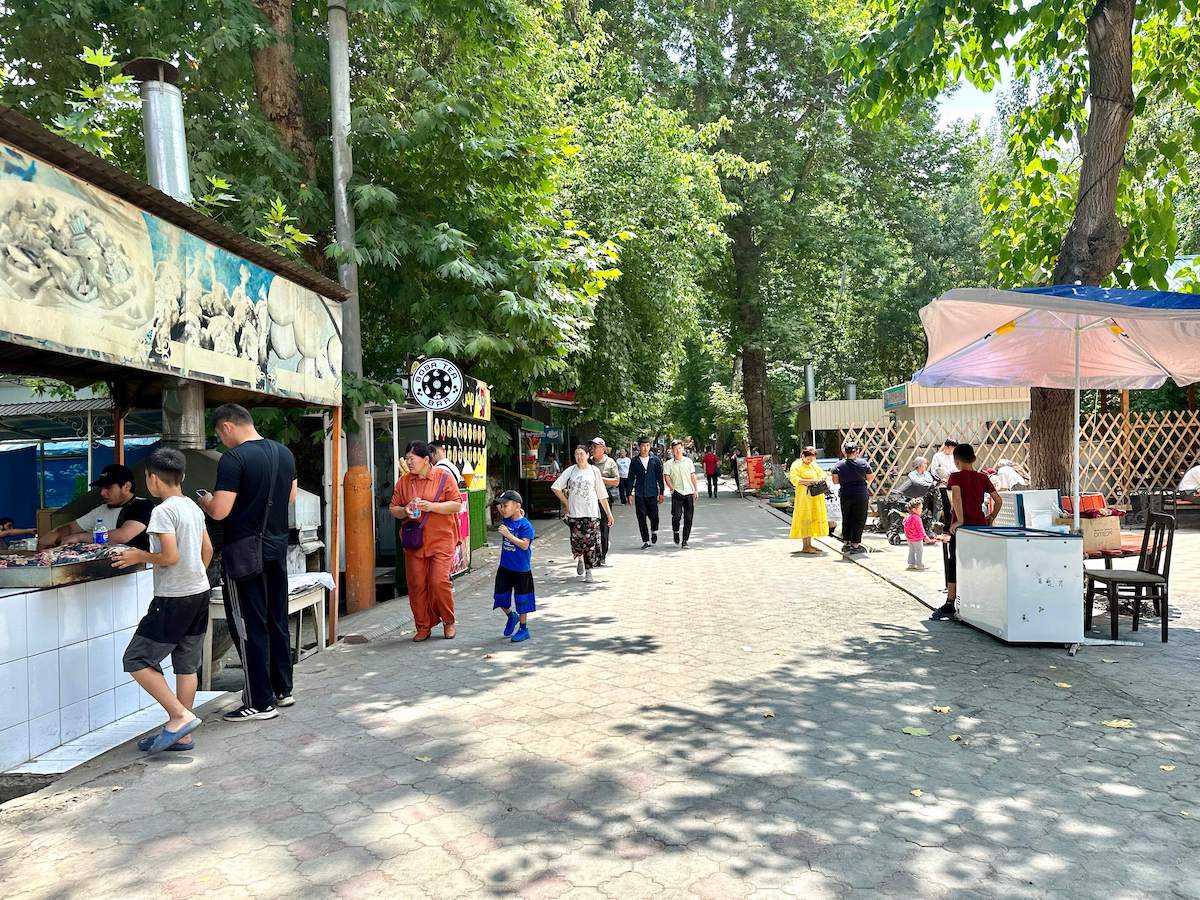
Tulpar Kul Lake (Osh Region)
Length: 1 night
Distance: 5 hours from Osh City by car
Accommodation: Tilek Yurt Camp, which had yurts with comfortable beds and heaters, clean bathrooms with western toilets, and delicious food. Even if Booking.com says you can’t book, you should still be able to through a tour operator or by contacting them.
Continuing with our 2-week Kyrgyzstan itinerary, we depart Osh heading south down the scenic Pamir Highway—once part of the Silk Road—with a new guide and driver, Almaz.
We pass enormous green hills puffing up from the earth with tree-lined spines, rocky mountains sprouting toward the sky with rushing rivers below, and snow-capped peaks in the distance—the highway winding below as we gaze up in amazement at the many colors and shapes.
 Quick tip: the Pamir Highway is full of trucks, and the gasoline smell can be overwhelming. I suggest having a face mask handy and keeping your windows closed.
Quick tip: the Pamir Highway is full of trucks, and the gasoline smell can be overwhelming. I suggest having a face mask handy and keeping your windows closed.
After a few hours, the road comes to Taldyk Pass—which reaches 3,615 meters (11,860 feet) and winds above the valley with tremendous drops. This section of the road is apparently quite treacherous in wintertime, especially with rocks tumbling down from above.
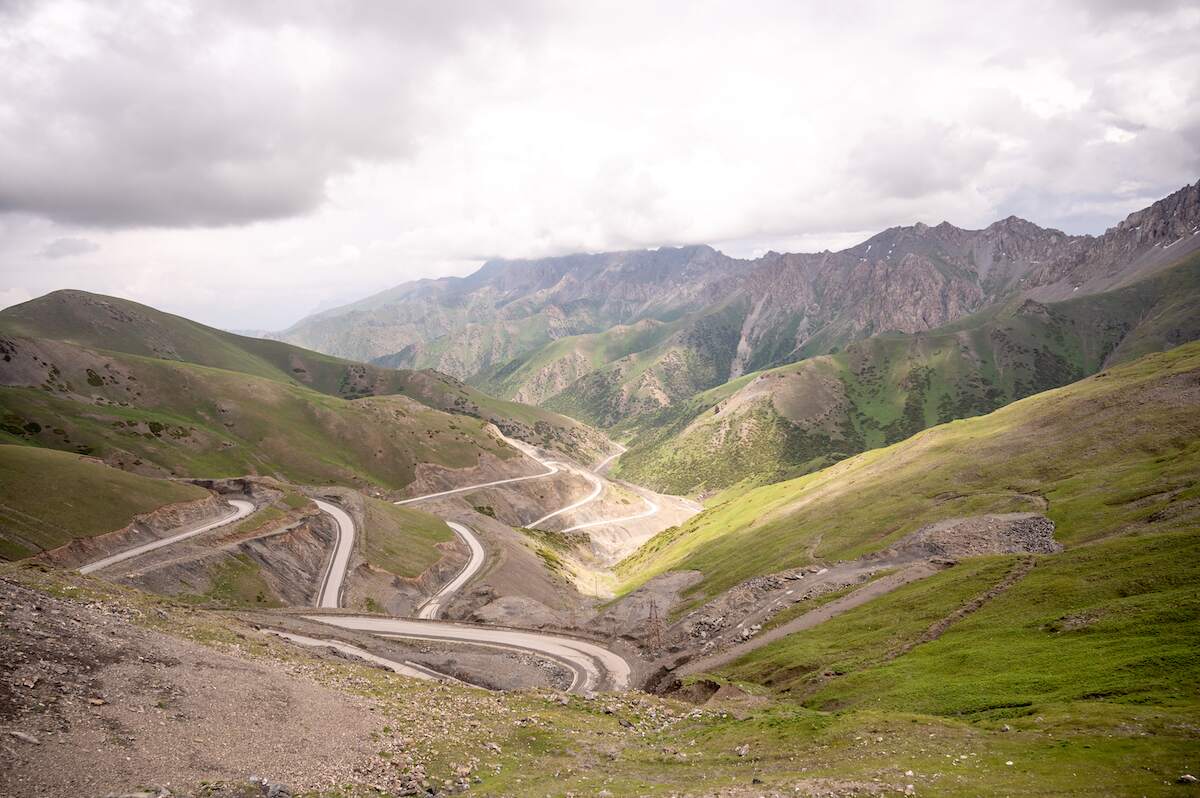
Sary-Tash is a crossroads village with roads leading to China to the left and Tajikistan to the right—the snow-capped Pamir Mountains creating a natural border.
After about 30 minutes, the Alay Mountains come into view opposite the Pamir Mountains, as we cruise through the Alay Valley until reaching Sary Mogul Village for lunch at the home of Almaz and his family.
From here, it’s 35 kilometers (22 miles) down Mountain Road toward Tulpar Kul Lake, snow-covered peaks behind multi-colored mountains filling the view of the windshield.
Our home for the night is Tilek Yurt Camp. Along with amazing hospitality, it’s a great spot for shooting sunset and sunrise over Tulpar Kul Lake, its yurt camps and animals, and the surrounding mountains.
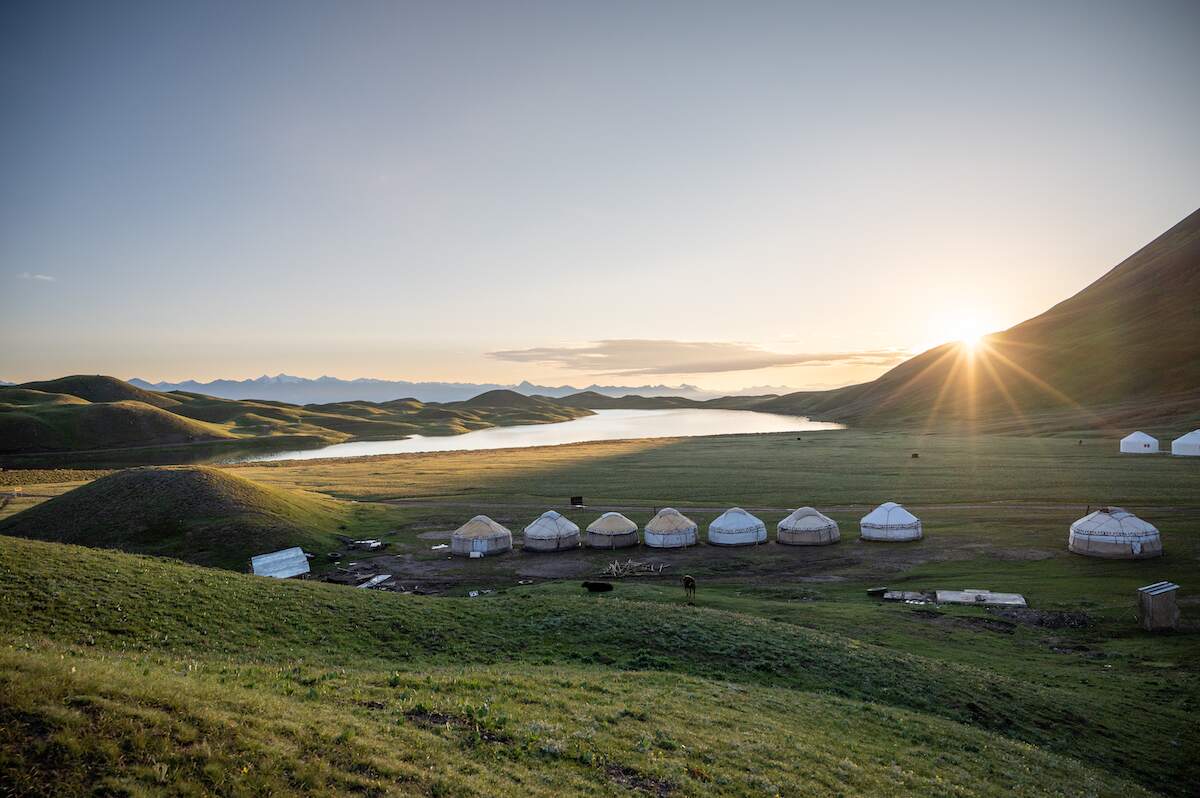
The following morning is the first day of our 4-day trek, and we’ll be hiking through the famous Traveler’s Pass—which will take us to 4,150 meters (13,616) for views of the Pamir Mountains and one of its highest points, the 7,134-meter (23,406-foot) Lenin Peak.
While the hike begins relatively flat, it isn’t long before we’re climbing uphill and the altitude sickness starts to kick in.
If you do this trek, keep in mind that you’ll be gaining about 650 meters (2,133 feet) of elevation, so it’s quite a challenge.
And, it isn’t the only one we run into. Shortly after passing a yellow sign letting us know we’re about 5 hours from Camp 1, we realize that the path is going to get very snowy and icy.
While it wouldn’t be impossible to trek with poles and proper gear, our group is a bit unprepared, so we switch to the much shorter Kyzyl Bel Trail—which provides a similar view from 3,959 meters (12,990 feet).
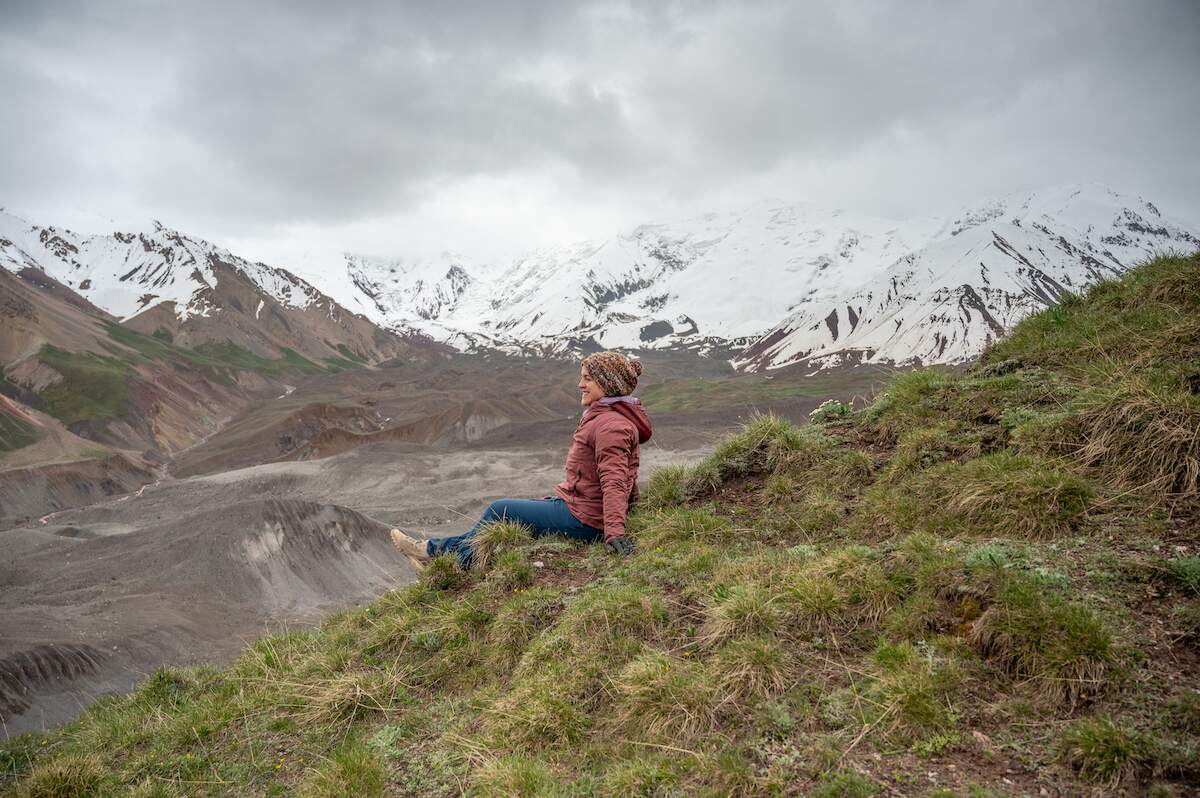
Once the clouds part, we get a pretty solid view of Lenin Peak.
After a picnic lunch, the sun comes out, allowing us to really enjoy the beauty of the trail that had felt so impossible on the way up.
From fields of wildflowers and edelweiss to orange marmots to epic peak views and colorful mountains, the scenery is some of the best I’ve seen on my travels.
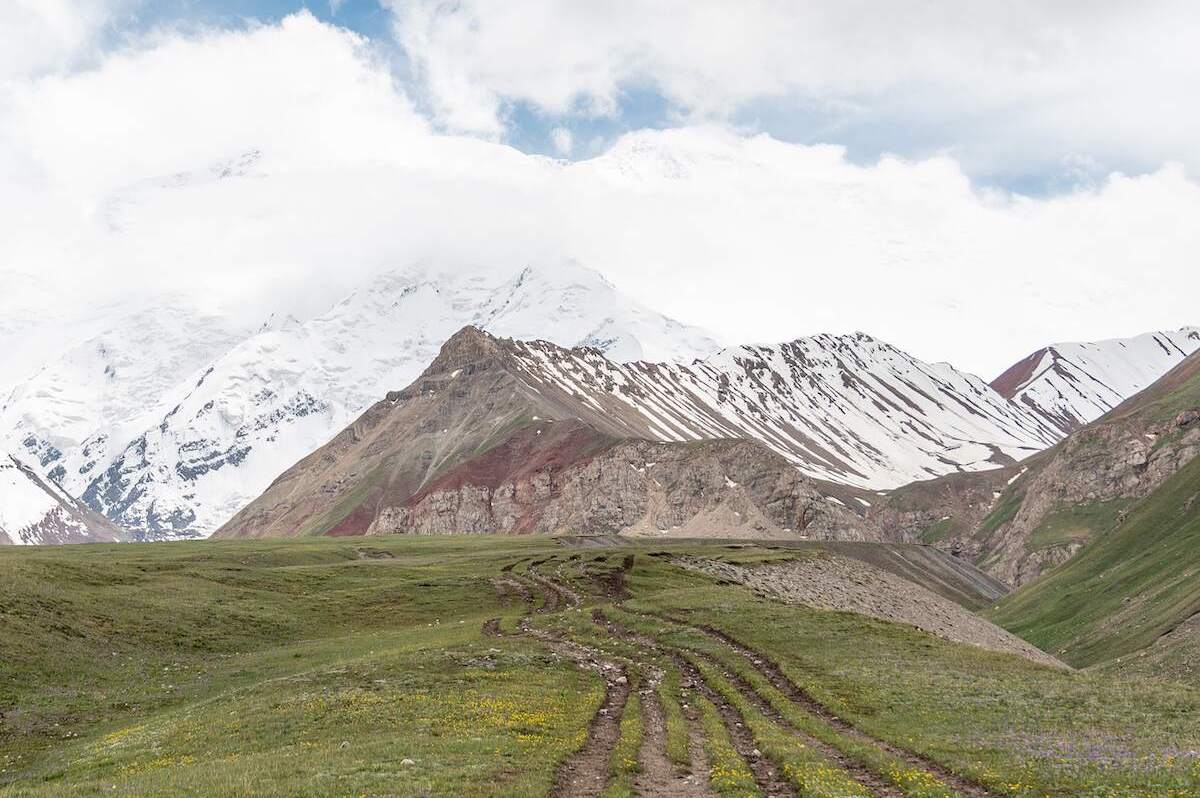
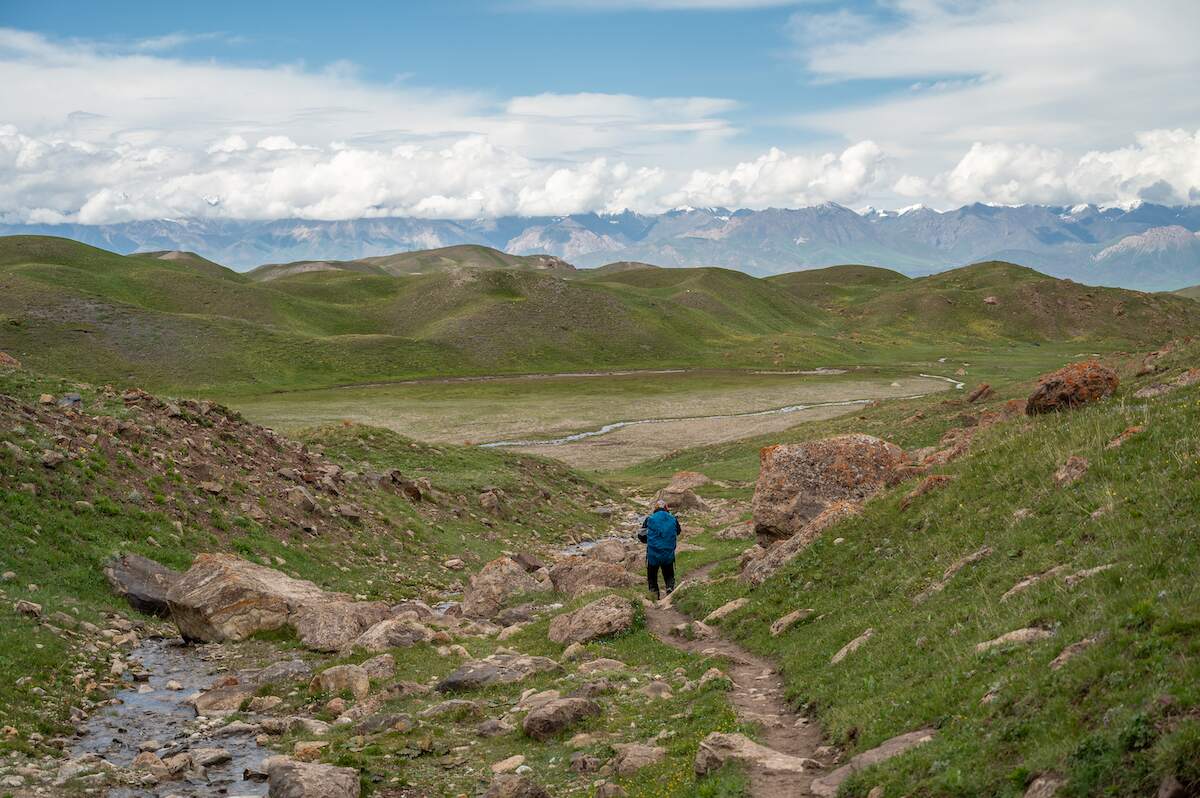
Sary Mogul Village (Osh Region)
Length: 1 night
Distance: Less than an hour from Tulpar Kul Lake by car
Accommodation: Sary Mogul Tunguch Guesthouse, a clean and comfortable guesthouse with a hot shower and western toilets.
That evening we stay at the Sary Mogul Tunguch Guesthouse run by Almaz and his family—the same place we had lunch the day prior—to rest up for our biggest section of trekking the following day.
Sary Mogul is mainly a place for trekking, horseback riding, and taking in beautiful views, so even if you’re not doing the Heights of Alay hike during your 2 weeks in Kyrgyzstan, you’ll have plenty of options.

Sary Mogul Pass (Osh Region)
Length: 1 night
Distance: 7-10 hours of trekking
Accommodation: Sary Mogul Yurt Camp, a clean and comfortable yurt camp with amazing views
The goal of this day in the Kyrgyzstan itinerary is trekking over two passes—Aktor Pass and Sary Mogul Pass—to reach 4,306 meters (14,127 feet).
While we know the altitude will be challenging, we aren’t prepared for the insanity that happens on the downhill.
Let me explain. The hike begins relatively easily as a flat path along a river, though soon becomes challenging with numerous uphills and downhills.
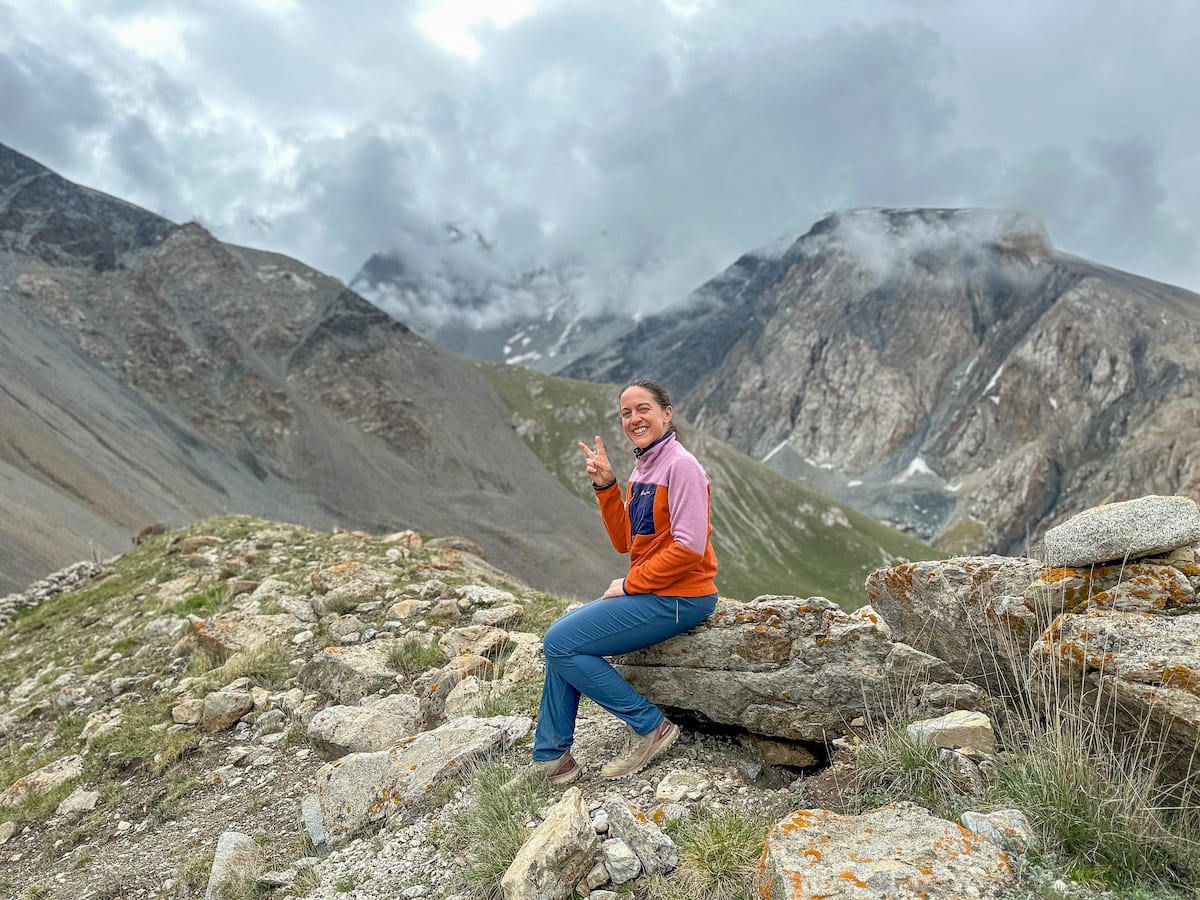
The views along the way are lovely, especially when we stop for a picnic lunch while sitting on the water with mountain views.
Afterward, it continues to be relatively gradual until the last push—300 meters completely uphill. It’s brutal, especially with the elevation, but the views of the Alay Mountains and surrounding lakes and glaciers from the top are epic!
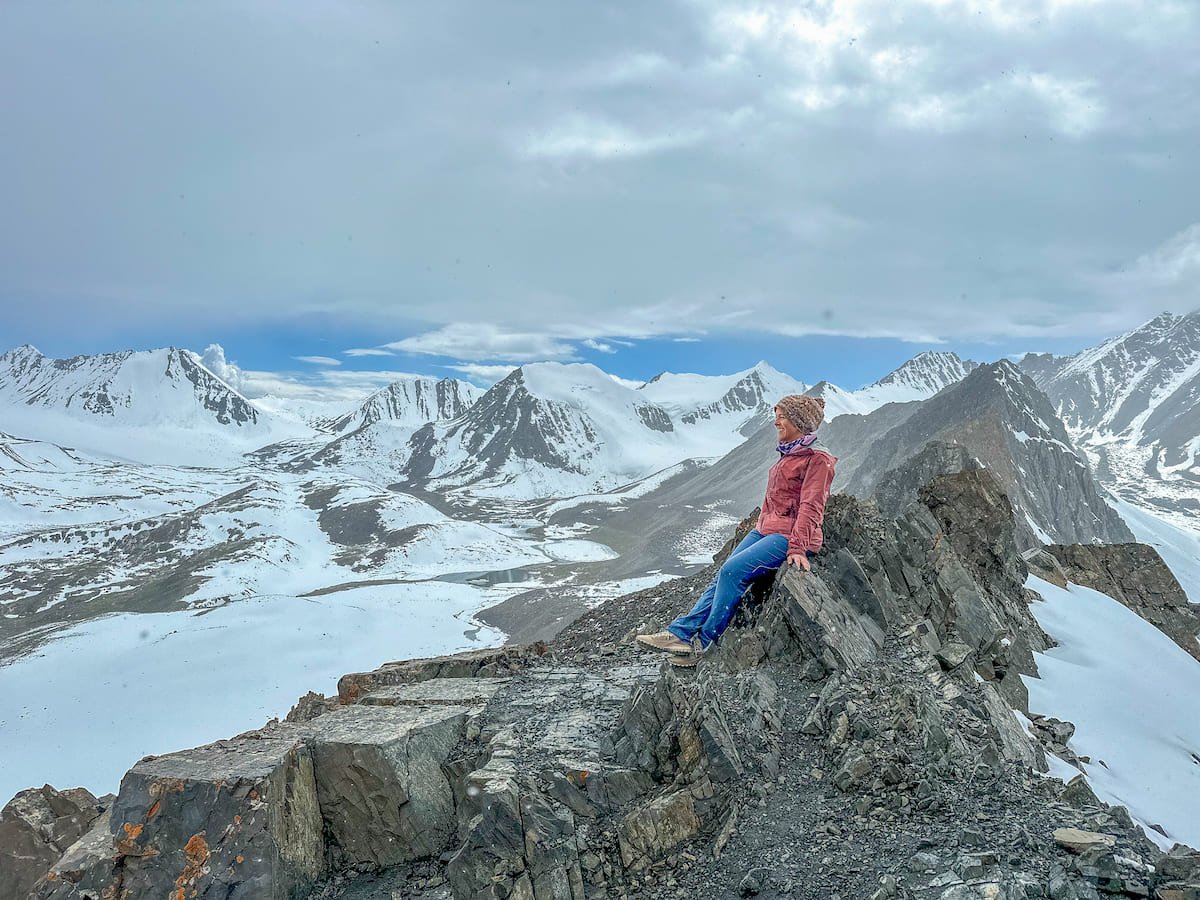
The caveat: since we’re a bit early in the season, the way down is completely covered in snow so deep and on a trail so steep and slippery with scree we have to glissade down while holding a rope.
Once the rope ends, we use our rain jackets as sleds to slide down the mountain.
After at least an hour, the snow ends and opens into a beautiful valley with yaks grazing and drinking from the river.
It’s peaceful, but we still have hours to go: there’s a crazy river crossing that leaves us soaking wet, some more uphill climbs, traversing uneven rock, and endless paths until we finally reach Sary Mogul Yurt Camp at 3,490 meters (11,450 feet)—after 10 hours of hiking!
Luckily, our yurt has a stove to warm our clothes, not to mention stunning views of the Kichik Alay Valley and its mountains. It’s one of the best views of the trip.
Note that we were told there wouldn’t be snow, so regardless of what you’re told, I’d be prepared for it, especially if you’ll be hiking before July.
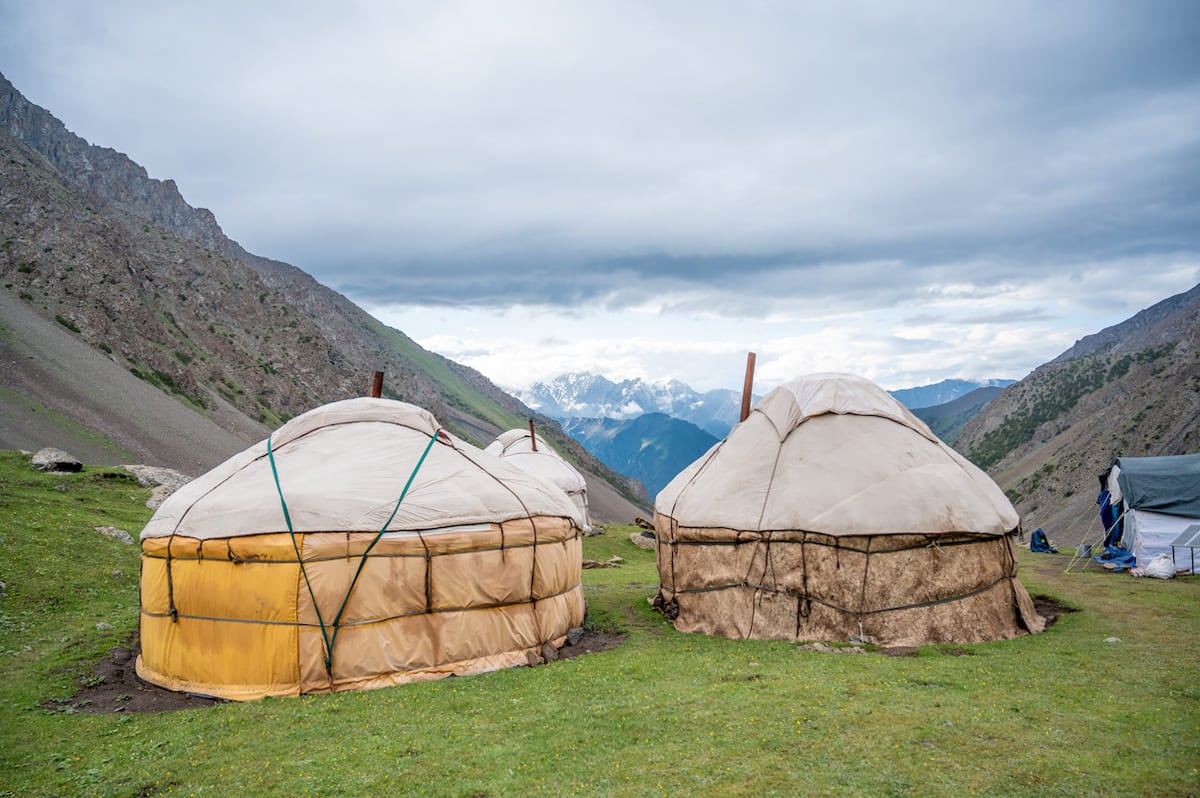
Kosh Moinok Valley (Naryn Region)
Length: 1 night
Distance: 7-10 hours of trekking
Accommodation: Kosh Moinok Yurt Camp
Luckily, the next day’s hike is leisurely and scenic, as we descend deeper into the Kichik Alay Valley, making our way to Kosh Moinok Valley.
The Alay Mountains remain in our vantage point, as well as beautiful countryside views. Cows graze, crystalline rivers flow, colorful flowers blow in the breeze, locals work outside their yurts, and distant mountains stretch toward the clouds. It’s an idyllic and relaxing hike.
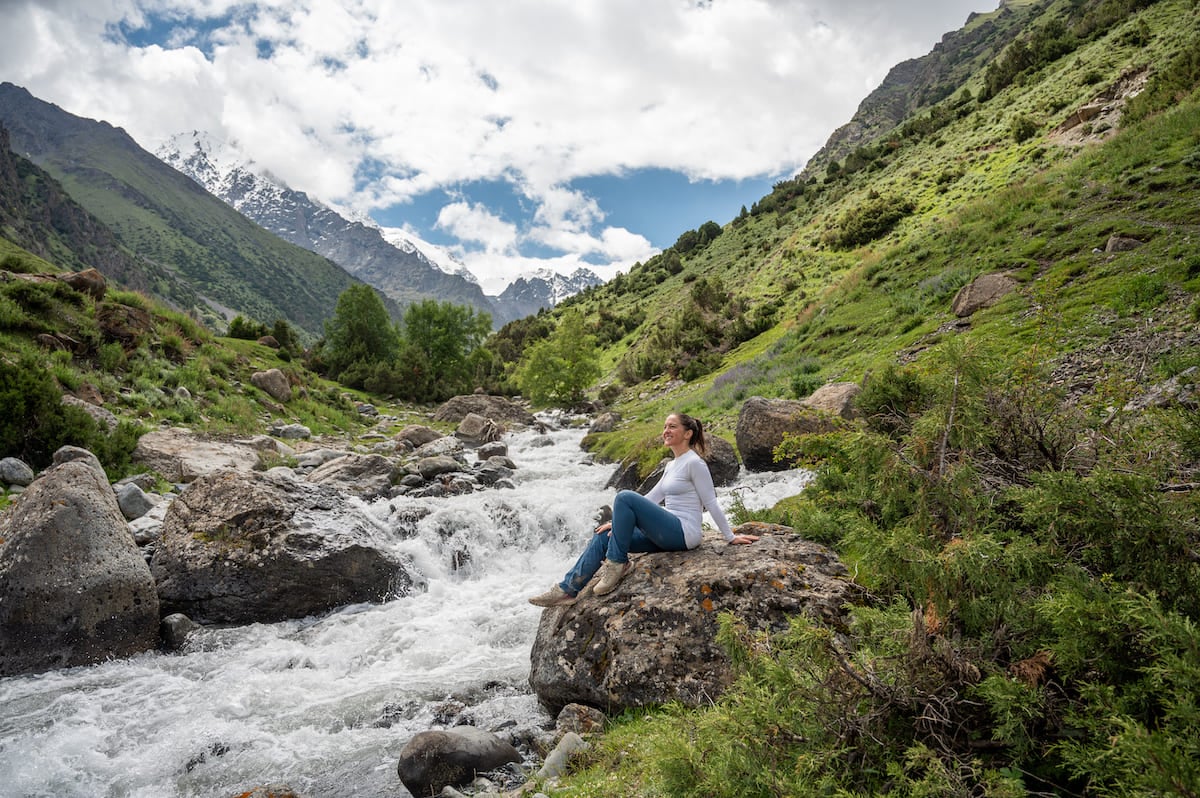
Well, at least it starts that way. After lunch at a guest house owned by Visit Alay in Kyzyl Shoro Village, the trail goes from descents and straight paths to a strenuous uphill climb—until we reach Kosh Moinok Pass at 3,210 meters (10,532 feet).
While difficult, you’ll quickly forget your pain as you gaze south toward the Pamir Mountains and then north toward the Alay Mountains. It’s breathtaking.

The descent toward Kosh Moinok Yurt Camp is steep, albeit scenic, especially as you’ll see many animals along the way. Donkeys, cows, and horses graze, run, and nuzzle with the beautiful mountains in the background.
Osh City via Sarybell Pass (Osh Region)
Length: 1 night
Distance: 5 hours of trekking and 3-5 hours of driving
Accommodation: Osh Grand Hotel Chavo, a comfortable and clean hotel with a restaurant and air-conditioned rooms
Today is the final leg of the revised Heights of Alay Trek—to Sarybell Pass at 3,132 meters (10,276 feet) and then down to Kojokelen Village.
Almost immediately, the trail bends steeply uphill. Once at the top, the views are incredible, as you see both the Pamir and Alay Mountain ranges at once. Plus, there are loads of adorable cows milling about!

Of course, what goes up must come down, and the descent is scenic but a knee-killer (a knee brace is recommended if you have even slightly achy knees).
Smells of wild mint and juniper mix with cow manure, and we see crazy plants that look straight out of a Dr Seuss book.
The views also get better and better, especially when we get to the Three Dragon Gorge and see dramatic, jagged red cliffs and verdant slopes unlike anything else we’ve seen during our entire Kyrgyzstan trip.

The views continue to be stunning thanks to the colorful plants, unique rock formations, and mountain peaks as we make our way down to Kojokelen Village for delicious plov lunch at a local Visit Alay guesthouse.
From there, it’s back to Osh City for a night at the Grand Hotel Chavo before an early flight back to the United States the following day.
You can also choose to head straight back to Bishkek tonight to get closer to the international airport, though you’ll want to book the latest flight from Osh to Bishkek, as the journey to Osh City can be long as the roads aren’t great.
To book your domestic flight, visit Bookit or Bilet.
Shorter Kyrgyzstan Itineraries
Short on time? Here is how I would tweak the itinerary if you have less than 14 days in Kyrgyzstan:
5 Days in Kyrgyzstan. If your trip is only 5 days, consider whether you’d prefer a relaxing trip by car or a trekking trip.
For instance, with 5 days, you could do something like Bishkek, Kok-Jaiyk Valley, Bokonbaevo Village, Song Kol Lake, and then head back to Bishkek. Since the roads aren’t always the best, you’ll want to get back to Bishkek well ahead of your flight.
To play it safe, you might also simply spend your time doing the many fun day trips from Bishkek.
If you prefer trekking, you could fly to Osh from Bishkek and do the Heights of Alay hiking portion of the above-mentioned 2-week Kyrgyzstan itinerary.
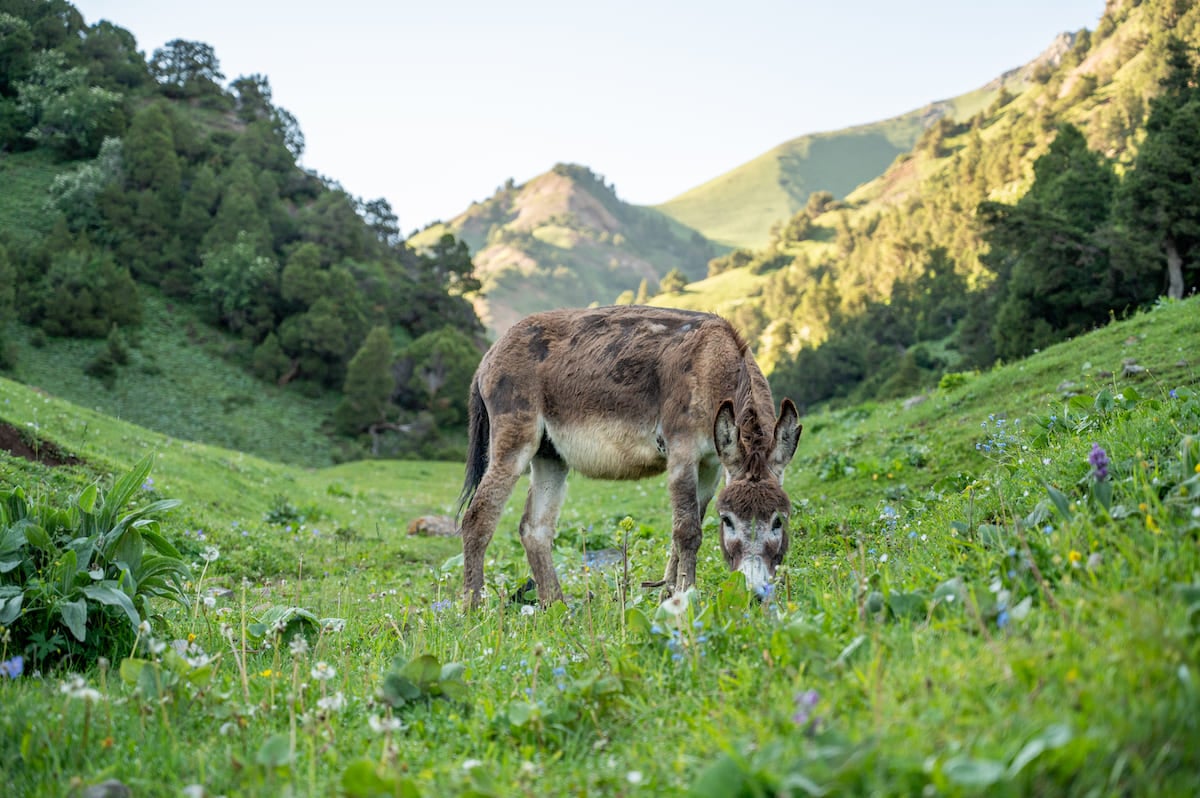
7 Days In Kyrgyzstan. With a few more days, you could do the full first week of the above-mentioned Kyrgyzstan itinerary, or you could opt for a longer hike. For instance, you could add 2 additional days of trekking to also go to Jiptick Yurt Camp and then over Jiptick Pass via Darbazatash Valley.
10 Days In Kyrgyzstan. With 10 Days in Kyrgyzstan, I’d keep the above 2-week itinerary almost the same except I’d spend one less day in Bishkek at the beginning and I’d cut Kazarman Village and Arslanbob Village. After Song Kol Lake, head back to Bishkek to fly to Osh and then do the trekking portion of the trip.
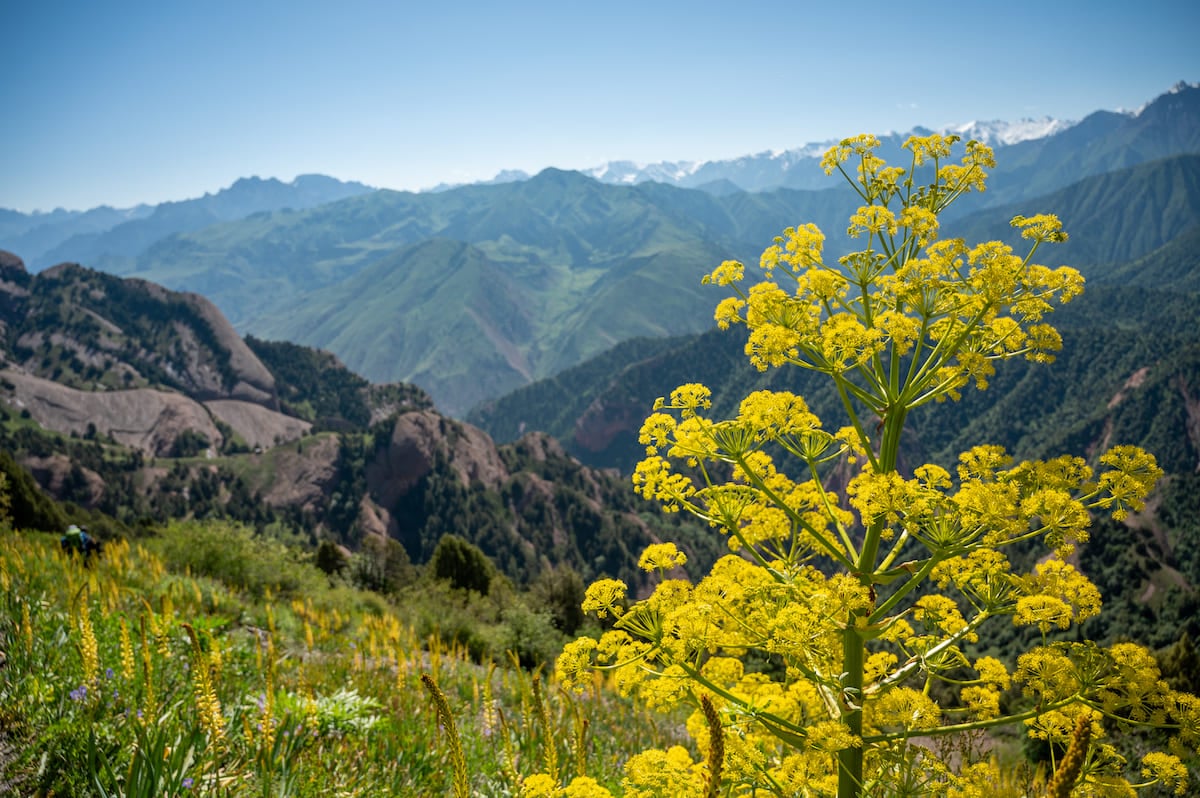
Tips For Planning A Trip To Kyrgyzstan
The following Kyrgyzstan travel tips can help you maximize your itinerary:
Consider hiring a guide and/or driver. I booked both through Visit Alay, which allowed me to learn interesting history and cultural information from locals and also sit back and relax while enjoying the scenery. Having a local to show you around also helps with any language barriers.
Pack light & smart. This isn’t the type of itinerary where you need heels, makeup, or dresses. You’ll be fine with hiking pants and capris as well as moisture-wicking t-shirts and long-sleeve shirts. I’ve shared a packing list below to help!
Also, if you are hiking with porters, bring a bag that they can carry on their back like a backpacking backpack or duffel bag (not a suitcase).
Understand how to dress as a female traveler. This was a question I had as a female traveler in Kyrgyzstan, a country that identifies as 90% Muslim, according to the US Department of State.
While some local women cover their hair, many don’t. You’ll also see a woman dress very modestly with high necklines and long sleeves walking with another woman in trendy jeans and a fitted tee. I also noticed that in some areas women seemed more conservatively dressed than others.
While you may feel out of place wearing tiny tank tops and shorts, t-shirts or lightweight long-sleeve shirts and capris or flowy pants work well. As you’ll often be sitting on floor cushions for meals, I don’t recommend dresses.
Eating vegetarian is semi-doable. While you’ll be able to find vegetarian food in the bigger cities, such as at Thai restaurants, locals may not understand this concept as you move to more rural places.
Having a guide to explain your dietary needs can help, though don’t be surprised if you end up simply taking the meat off the top of your food and giving it to someone else at your table.
Also, dishes that seem vegetarian may not be. For instance, while locals would take the meat off my plov, I later learned it’s still made with sheep fat. Hey, I did the best I could!
Trying to eat vegan in Kyrgyzstan? While there are simple salads and bread rounds with jam, you may want to bring your own food or risk going hungry!
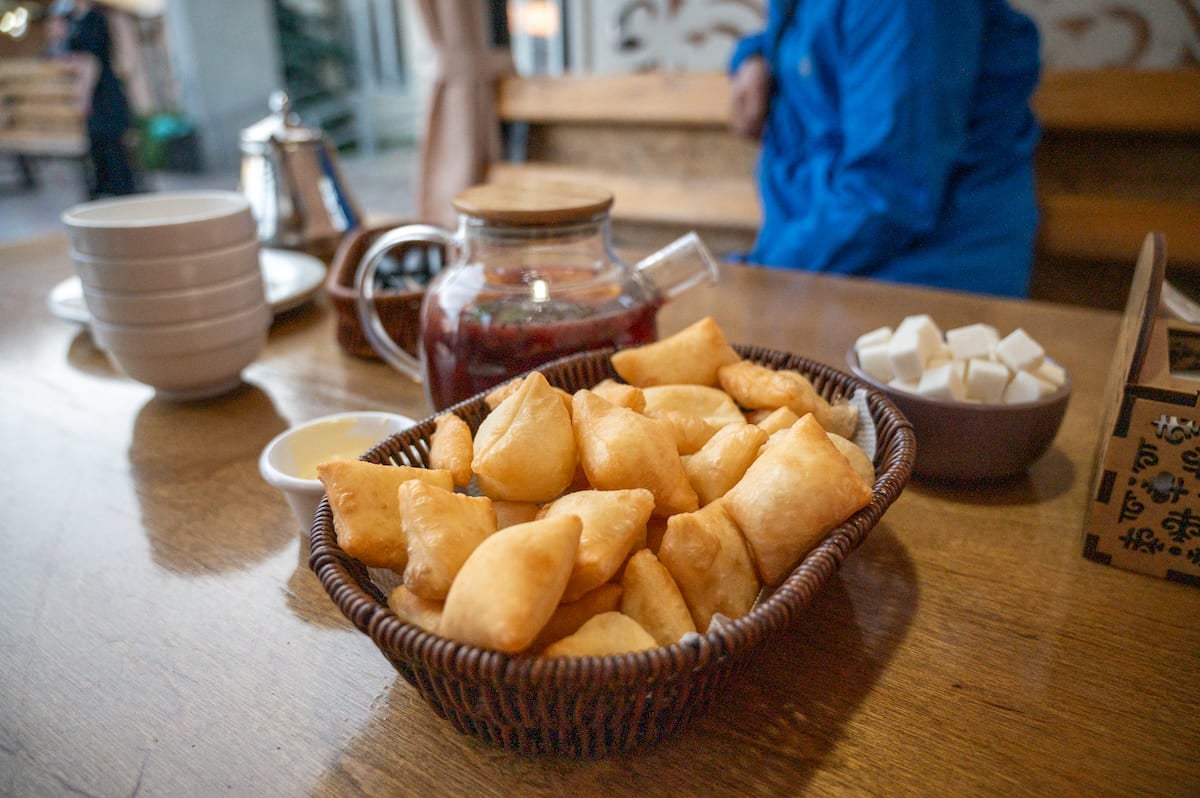
You’ll eat a lot of sweets. Whether you’re eating breakfast or dinner or it’s simply tea time, the tables you’ll dine at will almost always feature bowls of chocolate and candy as well as cookies and jams. It’s a sweet way to welcome you.
Public toilets are usually smelly pits. Be prepared to squat, hold your nose, and bring your own toilet paper and hand sanitizer. Personally, I always had a face mask laced with a drop of essential oils on hand to help hide the smell.
Train for Kyrgyzstan trekking. The hiking in Kyrgyzstan is no joke, especially since it’s also high altitude. It’s recommended that if you’ll be trekking in Kyrgyzstan you train before you arrive.
There are no drone laws. At least at the time of writing. Fly away!
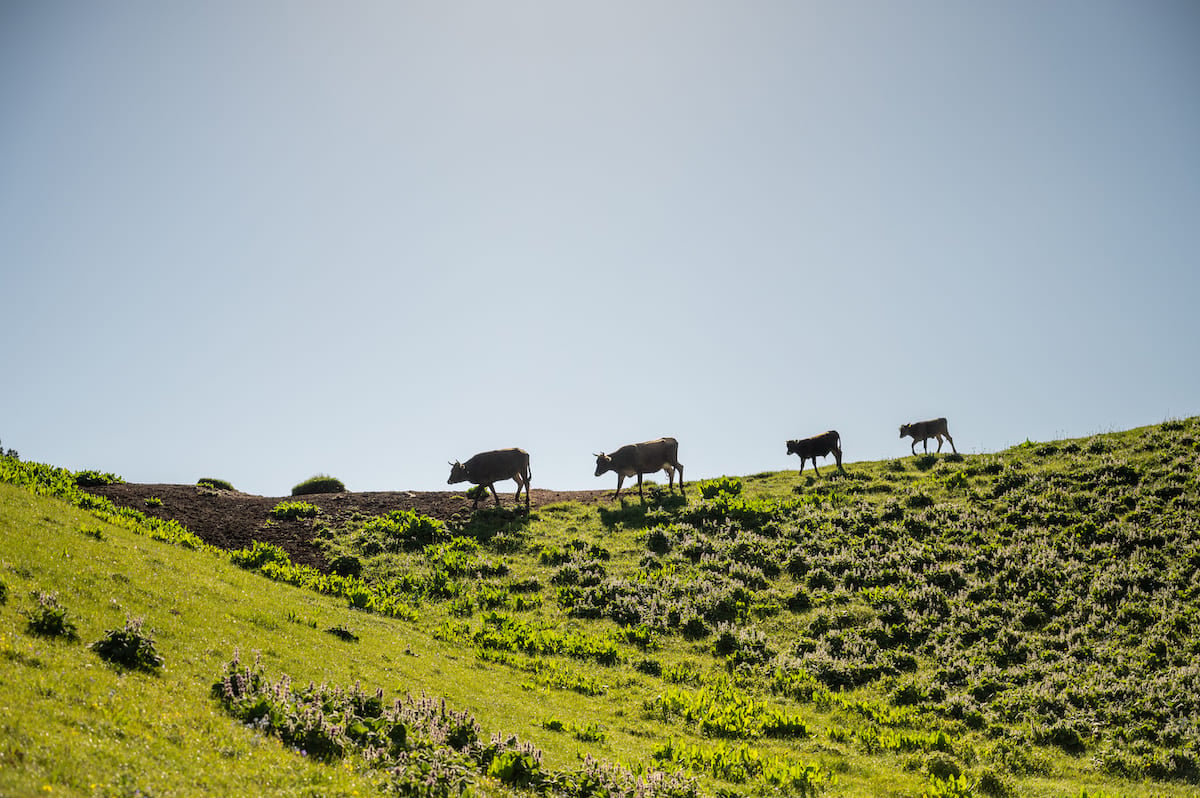
Kyrgyzstan Packing List
Along with your regular packing essentials, clothing, toiletries, and medications, a few specialty items to bring include the following.
Note: I visited in summer, which included many hot destinations as well as cold weather at higher altitudes, like in the Alay Mountains. A winter trip to Kyrgyzstan may require some additional items (check with your guide!).
Hygiene Items
- Toilet paper (many public toilets won’t have any)
- Biodegradable cleansing wipes (there aren’t always showers)
- Hand sanitizer
- Face mask for smelly toilets
Hydration & Sun Protection
- Water bottle or hydration bladder
- Portable water filter
- Chapstick with SPF
- Polarized sunglasses
- Sunscreen
- Hat
Outdoor Adventure Essentials
- Down jacket
- Rain jacket
- Rain pants
- Daypack with waterproof cover
- Waterproof duffel or backpack for the porter to carry (I love my North Face Base Camp Duffel, which survived rain, snow, and hail without getting any moisture inside)
- Hiking snacks
- Moisture-wicking base layer
- Hiking boots with Gore-Tex
- Moisture-wicking socks
- Sock liners
- Moleskine adhesive
- Knee brace for hiking (if steep downhill ascents bother your knees)
- Portable charger since there aren’t always outlets
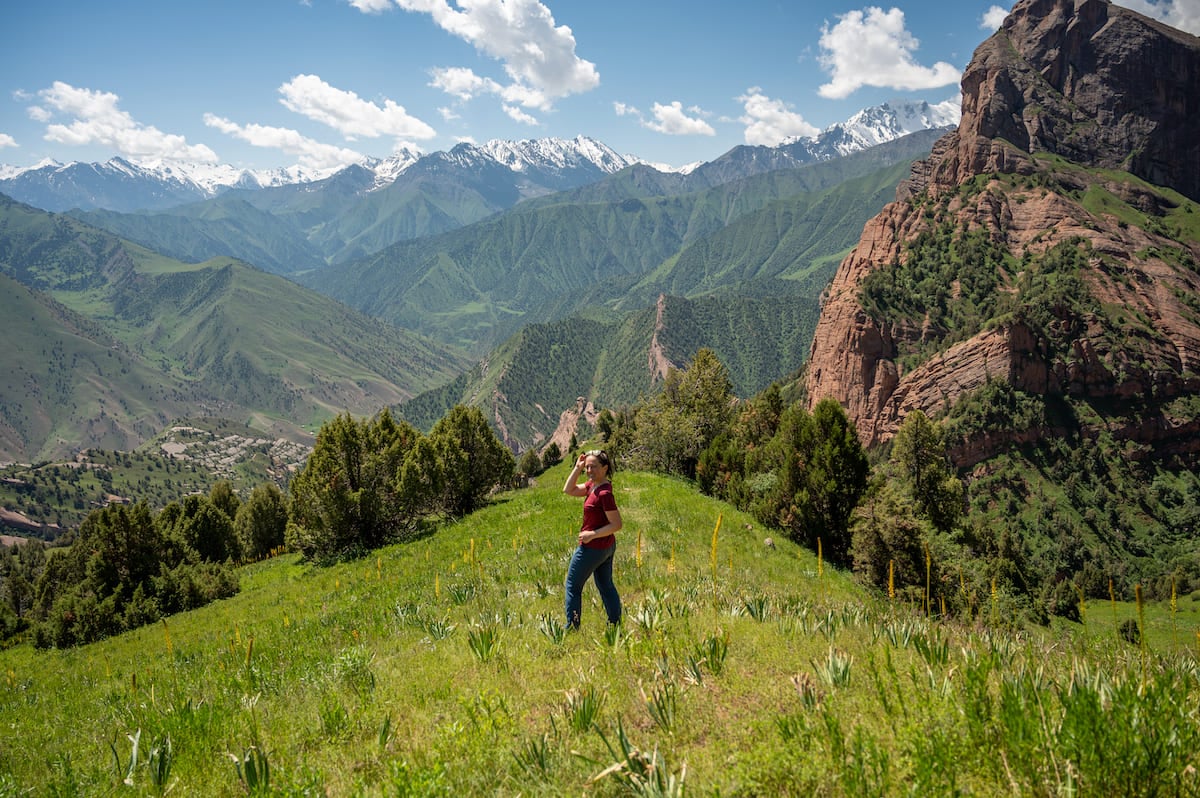
Kyrgyzstan Travel Itinerary Planning FAQ
Here are answers to frequently asked questions about planning the perfect Kyrgyzstan itinerary:
Q) Why do people go to Kyrgyzstan?
A few of the top reasons travelers go to Kyrgyzstan include the raw natural beauty, adventure sports like trekking and horseback riding, some of the most beautiful hiking trails in the world, and the chance to immerse themselves in local culture in a place not overrun by mass tourism.
Q) How many days are enough for Kyrgyzstan?
As there is a lot to see in Kyrgyzstan, I recommend a minimum of 10 days, though 14 is even better. Also keep in mind if you’re visiting from far away, you’ll need a day or two to acclimate to the new timezone.
Q) Is Kyrgyzstan cheap for tourists?
While the idea of “cheap” is relative to individual travelers, many will find it more budget-friendly than other popular destinations.
For example, looking at Kyrgyzstan travel costs, you can easily order a filling meal at a restaurant for $2-$4, and a guesthouse or yurt stay including room and board is about $20-$35 per night per person (shared with one other person).
In the largest city of Bishkek, a room at a 4-star hotel outside the city center was about $70 per night.
Q) Is Kyrgyzstan safe to travel?
I felt very safe traveling Kyrgyzstan, though consider avoiding the border with Tajikistan, which is prone to conflict.
Q) Is it easy to plan a backpacking Kyrgyzstan itinerary?
Yes, especially as Kyrgyzstan is budget-friendly. Plus, it’s easy to meet other travelers as most guesthouses and yurt camps have communal dining. You’ll also find hostels in the larger cities.
Q) Is Kyrgyzstan friendly to the USA?
Personally, I found that the locals I met were excited to hear I was from the United States. Everyone made me feel very welcome!
Q) Is alcohol legal in Kyrgyzstan?
Yes, alcohol is legal in Kyrgyzstan if you are over the age of 18 and aren’t driving a vehicle.
Q) What is the best month to visit Kyrgyzstan?
To maximize your chances for good weather, it’s recommended to go to Kyrgyzstan in July or August.

Kyrgyzstan Travel Insurance
When spending 2 weeks in Kyrgyzstan, it’s recommended to get travel insurance. For this, I have a few recommendations:
SafetyWing. If you’re looking for something straightforward and budget-friendly, you can’t beat SafetyWing. They offer one global policy that you can cancel at any time or continue paying for long-term coverage (making it the perfect option for digital nomads!).
Their plan includes medical coverage, trip interruptions, personal liability, unplanned overnight stays, lost luggage, and more.
World Nomads. For something more comprehensive, World Nomads is a great option. While you’ll pay a bit more, you’ll typically get higher coverage maximums as well as additional inclusions—like trip cancellation.
For this, I have two recommendations:
SafetyWing. If you’re looking for something straightforward and budget-friendly, you can’t beat SafetyWing. They offer one global policy that you can cancel at any time or continue paying for long-term coverage (making it the perfect option for digital nomads!).
Their plan includes medical coverage, trip interruptions, personal liability, unplanned overnight stays, lost luggage, and more.
World Nomads. For something more comprehensive, World Nomads is a great option. While you’ll pay a bit more, you’ll typically get higher coverage maximums as well as additional inclusions—like trip cancellation.
Global Rescue. If you’ll be trekking in Kyrgyzstan, it’s recommended to get a Global Rescue plan, which offers air evacuation services in case you get hurt or there is an emergency. At checkout, they also offer a travel insurance add-on.

Final Thoughts On Planning A Trip To Kyrgyzstan
I hope you enjoyed this Kyrgyzstan travel blog! If you’re looking to explore one of the most naturally beautiful and culturally rich places on earth, Kyrgyzstan is an excellent choice.
Explore the bigger cities of Bishkek and Osh, take in the beauty of the Alay and Pamir Mountains, trek over gorgeous mountain passes, stay in yurts and local guesthouses, and savor local dishes like manti (dumplings) and plov.
And if you follow the above-mentioned Kyrgyzstan travel guide, you’ll experience some of the best that the Alps of Central Asia has to offer!



